《国际经济学》试卷13
国际经济学试卷试题包括答案.docx
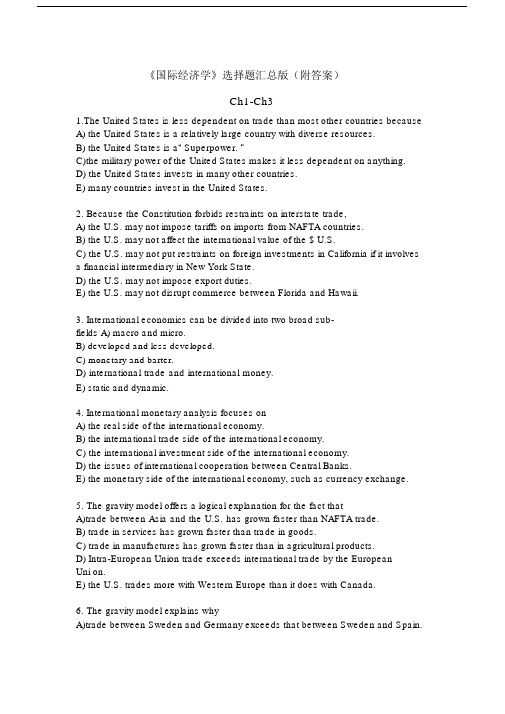
《国际经济学》选择题汇总版(附答案)Ch1-Ch31.The United States is less dependent on trade than most other countries becauseA)the United States is a relatively large country with diverse resources.B)the United States is a“ Superpower. ”C)the military power of the United States makes it less dependent on anything.D)the United States invests in many other countries.E)many countries invest in the United States.2. Because the Constitution forbids restraints on interstate trade,A)the U.S. may not impose tariffs on imports from NAFTA countries.B)the U.S. may not affect the international value of the $ U.S.C)the U.S. may not put restraints on foreign investments in California if it involves a financial intermediary in New York State.D)the U.S. may not impose export duties.E)the U.S. may not disrupt commerce between Florida and Hawaii.3.International economics can be divided into two broad sub-fields A) macro and micro.B) developed and less developed.C) monetary and barter.D) international trade and international money.E) static and dynamic.4.International monetary analysis focuses onA)the real side of the international economy.B)the international trade side of the international economy.C)the international investment side of the international economy.D)the issues of international cooperation between Central Banks.E)the monetary side of the international economy, such as currency exchange.5.The gravity model offers a logical explanation for the fact thatA)trade between Asia and the U.S. has grown faster than NAFTA trade.B) trade in services has grown faster than trade in goods.C) trade in manufactures has grown faster than in agricultural products.D) Intra-European Union trade exceeds international trade by the EuropeanUni on.E) the U.S. trades more with Western Europe than it does with Canada.6.The gravity model explains whyA)trade between Sweden and Germany exceeds that between Sweden and Spain.B)countries with oil reserves tend to export oil.C)capital rich countries export capital intensive products.D)intra-industry trade is relatively more important than other forms of tradebetween neighboringcountries.E)European countries rely most often on natural resources.7. Why does the gravity model work?A)Large economies became large because they were engaged in international trade.B)Large economies have relatively large incomes, and hence spend more on governm ent promotion of trade and investment.C)Large economies have relatively larger areas which raises the probability that a pro ductive activity will take place within the borders of that country.D)Large economies tend to have large incomes and tend to spend more on impor ts.E) Large economies tend to avoid trading with small economies.8.We see that the Netherlands, Belgium, and Ireland trade considerably more with the United States than with many other countries.A)This is explained by the gravity model, since these are all large countries.B)This is explained by the gravity model, since these are all small countries.C)This fails to be consistent with the gravity model, since these are smallcountri es.D)This fails to be consistent with the gravity model, since these are large countries.E)This is explained by the gravity model, since they do not share borders.9.In the present, most of the exports from Chinaare A) manufactured goods.B) services.C)primary products including agricultural.D) technology intensive products.E) overpriced by world market standards.10.A country engaging in trade according to the principles of comparative advantage gains from trade because itA) is producing exports indirectly more efficiently than it could alternatively.B) is producing imports indirectly more efficiently than it could domestically.C) is producing exports using fewer labor units.D) is producing imports indirectly using fewer labor units.E) is producing exports while outsourcing services.11.The Ricardian model attributes the gains from trade associated with the principle o f comparative advantage result toA) differences in technology.B)differences in preferences.C)differences in labor productivity.D)differences in resources.E)gravity relationships among countries.12. A nation engaging in trade according to the Ricardian model will find itsconsump tion bundleA)inside its production possibilities frontier.B)on its production possibilities frontier.C)outside its production possibilities frontier.D)inside its trade-partner's production possibilities frontier.E)on its trade-partner's production possibilities frontier.13.Assume that labor is the only factor of production and that wages in the United Sta tes equal $20 per hour while wages in Japan are $10 per hour. Production costs would be lower in the United States as compared to Japan ifA)U.S. labor productivity equaled 40 units per hour and Japan's 15 units per hour.B)U.S. labor productivity equaled 30 units per hour and Japan's 20 units per hour.C)U.S. labor productivity equaled 20 units per hour and Japan's 30 units per hour.D)U.S. labor productivity equaled 15 units per hour and Japan's 25 units per hour.E)U.S. labor productivity equaled 15 units per hour and Japan's 40 units per hour.14.In a two-country, two-product world, the statement“ Germanyenjoys acomparativ e advantage over France in autos relative toships ”is equivalent toA) France having a comparative advantage over Germany in ships.B) France having a comparative disadvantage compared to Germany in autos and ship s.C) Germany having a comparative advantage over France in autos and ships.D) France having no comparative advantage over Germany.E) France should produce autos.15.If the United States' production possibility frontier was flatter to the widget axis, whereas Germany's was flatter to the butter axis, we know thatA)the United States has no comparative advantageB)Germany has a comparative advantage in butter.C)the U.S. has a comparative advantage in butter.D)Germany has comparative advantages in both products.E)the U.S. has a comparative disadvantage in widgets.Ch4-Ch51.The Ricardian model of international trade demonstrates that trade can bemutually beneficial. Why, then, do governments restrict imports of some goods?A)Trade can have substantial effects on a country's distribution of income.B)The Ricardian model is often incorrect in its prediction that trade can bemutually beneficial.C)Import restrictions are the result of trade wars between hostile countries.D)Imports are only restricted when foreign-made goods do not meet domestic standar ds of qualityE) Restrictions on imports are intended to benefit domestic consumers.2.Japan's trade policies with regard to rice reflect the fact thatA) japanese rice farmers have significant political power.B) Japan has a comparative advantage in rice production and therefore exports most o f its rice crop.C) there would be no gains from trade available to Japan if it engaged in free trade in r ice.D) there are gains from trade that Japan captures by engaging in free trade in rice.E) Japan imports most of the rice consumed in the country.3.In the specific factors model, which of the following is treated as a specific factor?A)LaborB)LandC)ClothD)FoodE)Technology4.The specific factors model assumes that there are ________ goods and ________ fa ctor(s) of production.A) two; threeB) two; two C)two; one D)three; two E)four; three5.The slope of a country's production possibility frontier with cloth measured on the horizontal and food measured on the vertical axis in the specific factors model is equa l to ________ and it ________ as more cloth is produced.A)-MPLF/MPLC; becomes steeperB)-MPLF/MPLC; becomes flatterC)-MPLF/MPLC; is constantD)-MPLC/MPLF; becomes steeperE)-MPLC/MPLF; is constant6.Under perfect competition, the equilibrium price of labor used to produce clothwill be equal toA)the slope of the production possibility frontier.B)the average product of labor in the production of cloth times the price of cloth.C)the ratio of the marginal product of labor in the production of cloth to the marginal product of labor in the production of food times the ratio of the price of cloth. to the price of food.D)the marginal product of labor in the production of cloth times the price of cloth.E)the price of cloth divided by the marginal product of labor in the production of clot h.7.In the specific factors model, which of the following will increase the quantity ofla bor used in cloth production?A)an increase in the price of cloth relative to that of foodB) an increase in the price of food relative to that ofcloth C) a decrease in the price of laborD) an equal percentage decrease in the price of food and clothE) an equal percentage increase in the price of food and cloth8.A country that does not engage in trade can benefit from trade only ifA)it has an absolute advantage in at least one good.B)it employs a unique technology.C)pre-trade and free-trade relative prices are not identical.D)its wage rate is below the world average.E)pre-trade and free-trade relative prices are identical.9.In the specific factors model, the effects of trade on welfare are ________ for mobil e factors, ________ for fixed factors used to produce the exported good, and ________ for fixed factors used to produce the imported good.A)ambiguous; positive; negativeB) ambiguous; negative; positive C)positive; ambiguous; ambiguous D)negative; ambiguous; ambiguous E)positive; positive; positive10.The effect of trade on specialized employees of import-competing industries willb e ________ jobs and ________ pay because they are relatively ________.A)fewer; lower; mobileB)fewer; lower; immobileC)more; lower; immobileD)more; higher; mobileE)more; higher; immobile11. There is a bias in the political process against free trade becauseA)there is a high correlation between the volume of imports and the unemployment ra te.B)the gains from free trade cannot be measured.C)those who gain from free trade can't compensate those who lose.D)foreign governments make large donations to U.S. political campaigns.E) those who lose from free trade are better organized than those who gain.12.In the 2-factor, 2 good Heckscher-Ohlin model, the two countries differin A)tastes and preferences.B)military capabilities.C)the size of their economies.D)relative abundance of factors of production.E)labor productivities.13.If a country produces good Y (measured on the vertical axis) and good X (measure d on the horizontal axis), then the absolute value of the slope of its production possibil ity frontier is equal toA)the opportunity cost of good X.B) the price of good X divided by the price of good Y.C) the price of good X divided by the price of goodY. D) the opportunity cost of good Y.E)the cost of capital (assuming that good Y is capital intensive) divided by the costof labor.14.In the 2-factor, 2 good Heckscher-Ohlin model, trade will ________ the owners ofa country's ________ factor and will ________ the good that uses that factor intensiv ely.A)benefit; abundant; exportB)harm; abundant; importC)benefit; scarce; exportD)benefit; scarce; importE)harm; scarce; export15.The assumption of diminishing returns in the Heckscher-Ohlin model means that, unlike in the Ricardian model, it is likely thatA) countries will consume outside their production possibility frontier.B) countries will benefit from free international trade.C) countries will not be fully specialized in one product.D)comparative advantage will not determine the direction of trade.E)global production will decrease under trade.16.If Japan is relatively capital rich and the United States is relatively land rich, and if food is relatively land intensive then trade between these two, formerly autarkic coun tries will result inA)an increase in the relative price of food in the U.S.B)an increase in the relative price of food in Japan.C)a global increase in the relative price of food.D)a decrease in the relative price of food in both countries.E)an increase in the relative price of food in both countries.17.Starting from an autarky (no-trade) situation with Heckscher-Ohlin model, if Coun try H is relatively labor abundant, then once trade beginsA) rent will be unchanged but wages will rise in H.B) wages and rents should rise in H.C) wages and rents should fall in H.D) wages should fall and rents should rise in H.E) wages should rise and rents should fall in H.18.The Leontieff ParadoxA)failed to support the validity of the Heckscher-Ohlin model.B)supported the validity of the Ricardian theory of comparative advantage.C)supported the validity of the Heckscher-Ohlin model.D)failed to support the validity of the Ricardian theory.E)proved that the U.S. economy is different from all others.19. Which of the following is an assertion of the Heckscher-Ohlin model?A)Factor price equalization will occur only if there is costless mobility of all factors a cross borders.B)An increase in a country's labor supply will increase production of both the capital-intensive and the labor-intensive good.C)In the long-run, labor is mobile and capital is not.D)The wage-rental ratio determines the capital-labor ratio in a country's industr ies.E)Factor endowments determine the technology that is available to a country, which determines the good in which the country will have a comparative advantage.20. Which of the following is an assertion of the Heckscher-Ohlin model?A)An increase in a country's labor supply will increase production of the labor-i ntensive good and decrease production of the capital-intensive good.B)An increase in a country's labor supply will increase production of both the capital-intensive and the labor-intensive good.C)In the long-run, labor is mobile and capital is not.D)Factor price equalization will occur only if there is costless mobility of all factors a cross borders.E)Factor endowments determine the technology that is available to a country, which determines the good in which the country will have a comparative advantage.Ch6-Ch101.If the ratio of price of cloth (PC) divided by the price of food (PF) increases in thei nternational marketplace, thenA)the terms of trade of cloth exporters will improve.B)all countries would be better off.C)the terms of trade of food exporters will improve.D)the terms of trade of all countries will improve.E) the terms of trade of cloth exporters will worsen.2.If the ratio of price of cloth (PC) divided by the price of food (PF) increases in thei nternational marketplace, thenA)world relative quantity of cloth supplied will increase.B)world relative quantity of cloth supplied and demanded will increase.C)world relative quantity of cloth supplied and demanded will decrease.D)world relative quantity of cloth demanded will decrease.E)world relative quantity of food will increase.3.If the U.S. (a large country) imposes a tariff on its imported good, this will tend toA)have no effect on terms of trade.B)improve the terms of trade of the United States.C)improve the terms of trade of all countries.D)because a deterioration of U.S. terms of trade.E)raise the world price of the good imported by the United States.4.If Slovenia were a large country in world trade, then if it instituted a large set of sub sidies for its exports, this mustA)decrease its marginal propensity to consume.B)have no effect on its terms of trade.C)improve its terms of trade.D)harm its terms of trade.E)harm world terms of trade.5.Internal economies of scale arise when the cost per unitA)falls as the average firm grows larger.B)rises as the industry grows larger.C)falls as the industry grows larger.D)rises as the average firm grows larger.E)remains constant over a broad range of output.6. External economies of scale will ________ average cost when output is ________ by _______.A)reduce; increased; the industryB)reduce; increased; a firmC)increase; increased; a firmD)increase; increased; the industryE)reduce; reduce; the industry7.If some industries exhibit internal increasing returns to scale in each country, we sh ould not expect to seeA) perfect competition in these industries.B) intra-industry trade between countries.C)inter-industry trade between countries.D)high levels of specialization in both countries.E)increased productivity in both countries.8.A learning curve relates ________ to ________ and is a case of ________ returns.A) unit cost; cumulative production; dynamic decreasing returnsB)output per time period; long-run marginal cost; dynamic increasing returnsC)unit cost; cumulative production; dynamic increasing returnsD)output per time period; long-run marginal cost; dynamic decreasing returnsE)labor productivity; education; increasing marginal returns9.Patterns of interregional trade are primarily determined by ________ rather than __ ______ because factors of production are generally ________.A)external economies; natural resources; mobileB)internal economies; external economies; mobileC)external economies; population; immobileD)internal economies; population; immobileE)population; external economies; immobile10.Monopolistic competition is associatedwith A) product differentiation.B) price-taking behavior.C) explicit consideration at the firm level of the strategic impact of other firms' pricing decisions. D) high profit margins in the long run.E) increasing returns to scale.11.A firm in long-run equilibrium under monopolistic competition will earnA)positive monopoly profits because each sells a differentiated product.B)zero economic profits because of free entryC)positive oligopoly profits because each firm sells a differentiated product.D)negative economic profits because it has economies of scale.E)positive economic profit if it engages in international trade.12.The most common form of price discrimination in international tradeis A) dumping.B) non-tariff barriers.C) Voluntary Export Restraints.D) preferential trade arrangements.E) product boycotts.13.Consider the following two cases. In the first, a U.S. firm purchases 18% of a forei gn firm. In the second, a U.S. firm builds a new production facility in a foreign countr y. Both are ________, with the first referred to as ________ and the second as ______ __.A)foreign direct investment (FDI) outflows; brownfield; greenfieldB)foreign direct investment (FDI) inflows; greenfield; brownfieldC)foreign direct investment (FDI) outflows; greenfield; brownfieldD)foreign direct investment (FDI) inflows; brownfield; greenfieldE)foreign direct investment (FDI); inflows; outflows14. Specific tariffs areA)import taxes stated in specific legal statutes.B)import taxes calculated as a fixed charge for each unit of imported goods.C)import taxes calculated as a fraction of the value of the imported goods.D)the same as import quotas.E)import taxes calculated based solely on the origin country.15.A problem encountered when implementing an "infant industry" tariff isthat A) domestic consumers will purchase the foreign good regardless of thetariff. B) the industry may never "mature."C)most industries require tariff protection when they are mature.D)the tariff may hurt the industry's domestic sales.E)the tariffs fail to protect the domestic producers.16.In the country levying the tariff, the tariff will A)increase both consumer and producer surplus.B) decrease both the consumer and producer surplus.C) decrease consumer surplus and increase producer surplus.D) increase consumer surplus and decrease producer surplus.E) decrease consumer surplus but leave producers surplus unchanged.17.If the tariff on computers is not changed, but domestic computer producers shift fr om domestically produced semiconductors to imported components, then the effective rate of protection in the computer industry willA) increase.B) decreaseC) remain the same.D)depend on whether computers are PCs or "Supercomputers."E)no longer apply.18.When a government allows raw materials and other intermediate products to enter a country duty free, this generally results in a(an)A) effective tariff rate less than the nominal tariff rate.B) nominal tariff rate less than the effective tariff rate.C) rise in both nominal and effective tariff rates.D) fall in both nominal and effective tariff rates. E) rise in only the effective tariff rat e.19.Should the home country be "large" relative to its trade partners, its imposition ofa tariff on imports would lead to an increase in domestic welfare if the terms of thetra de rectangle exceed the sum of theA) revenue effect plus redistribution effect.B) protective effect plus revenue effect.C) consumption effect plus redistribution effect.D)production distortion effect plus consumption distortion effect.E)terms of trade gain.20.The efficiency case made for free trade is that as trade distortions such as tariffs ar e dismantledand removed,A) government tariff revenue will decrease, and therefore national economic welfare will decreaseB) government tariff revenue will decrease, and therefore national econo mic welfare will increase.C) deadweight losses for producers and consumers will decrease, henceincreasin g national economic welfare.D)deadweight losses for producers and consumers will decrease, hence decreasing na tional economic welfare.E)government tariff revenue will increase, hence increasing national economic welfar e.21.Which organization determines procedures for the settlement of international trade disputes?A)World BankB)World Trade OrganizationC)International Monetary OrganizationD)International Bank for Reconstruction and DevelopmentE)The League of Nations22.Today U.S. protectionism is concentratedin A) high-tech industries.B) labor-intensive industries.C) industries in which Japan has a comparative advantage.D)computer intensive industries.E)capital-intensive industries.23.The quantitative importance of U.S. protection of the domestic clothing industryis best explained by the fact thatA)this industry is an important employer of highly skilled labor.B)this industry is an important employer of low skilled labor.C)most of the exporters of clothing into the U.S. are poor countries.D)this industry is a politically well organized sector in the U.S.E)the technology involved is very advanced.欢迎下载1124.The optimum tariff is most likely to applyto A) a small tariff imposed by a small country.B) a small tariff imposed by a large country. C)a large tariff imposed by a small country. D) alarge tariff imposed by a large country. E) anad valorem tariff on a small country.25.The median voter modelA)works well in the area of trade policy.B)is not intuitively reasonable.C)tends to result in biased tariff rates.D)does not work well in the area of trade policy.E)is not widely practiced in the United States.欢迎下载12。
最新国际经济学考试试题完美版,含答案

全国2007年4月高等教育自学考试国际经济学试题课程代码00140一、单项选择题本大题共25小题每小题1分共25分在每小题列出的四个备选项中只有一个是符合题目要求的请将其代码填写在题后的括号内。
错选、多选或未选均无分。
1.从十五世纪初到十八世纪中叶在国际贸易和国际投资理论方面占主导地位的是AA.重商主义B.重农主义C.重金主义D.货币主义2.采取进口替代战略的国家不倾向使用的政策是DA.对进口关税设置壁垒B.对非关税设置障碍C.对外汇实行管制D.对本国货币低估对外价值3.相对技术差异论的提出者是BA.斯密B.李嘉图C.奥林D.赫克歇尔4.关税与贸易总协定进行了多轮多边贸易谈判其中谈判时间最长的是CA.日内瓦回合B.东京回合C.乌拉圭回合D.安纳西回合5.世界贸易组织成立于CA.1993年B.1994年C.1995年D.1996年6.一般而言外汇市场的参与者种类繁多下列不属于外汇市场主要参与者的是DA.商业银行B.中央银行C.外贸公司D.居民个人7.国际收支平衡表中最重要的收支差额是DA.官方结算差额B.商品贸易差额C.基本收支差额D.经常项目差额8.国际收支调整的重要基础理论是CA.调整论B.货币论C.弹性论D.平衡论9.从总体上看随着我国市场经济体制的建立和完善、产业结构的更新换代我国的进出口产品的需求弹性的绝对值将AA.大于1B.小于1C.等于1D.不确定10.在开放经济条件下如果边际消费倾向c=0.6边际储蓄率为s=0.3则外贸乘数为不考虑政府的财政收入部分CA.10/9B.5/3C.5/2D.10/311.下列属于非关税壁垒的措施是DA.反倾销税B.反补贴税C.进口附加税D.国内最低限价12.最佳关税来源于BA.进口国厂商B.出口国厂商C.第三国出口厂商D.第三国进口厂商13.20世纪90年代东南亚金融危机爆发的最直接原因是AA.泰国宣布放弃盯住汇率制度泰币大幅度贬值B.韩国财团破产C.香港股市大跌港币贬值D.日本经济大幅下滑14.特别提款权实质上是一种DA.货币B.基金C.债权D.记帐单位15.国际收入调整的货币理论中的价格—铸币流动机制提出者是CA.亚当·斯密B.保罗·克鲁格曼C.大卫·休谟D.彼得·凯恩16.在比较利益模型中参与贸易的两国商品的国际比价线CA.在两国贸易前的国内比价线之上B.在两国贸易前的国内比价线之下C.在两国贸易前的国内比价线之间D.与两国贸易前的国内比价线相同17.一A.出口方式B.直接投资方式C.发放许可证方式D.间接投资方式18.巴格瓦蒂等经济学家提出对希望移居外国的本国居民征收一部分税费目的是AA.可使移民的移出国获得某种补偿B.可补偿移出国的商品出口C.可补偿本国劳动力收入D.可补偿公共设施的不足19.重叠需求贸易理论从需求的角度对产业内贸易加以概括和解释对国际贸易理论的发展作出了重要贡献。
国际经济学考试试题

国际经济学考试试题一、单项选择题(每题 2 分,共 30 分)1、从国际经济资源流动的难度看,最容易流动的要素是()A 商品B 资本C 人员D 技术2、假定闭关自守的状态下,X 商品的价格,在 A 国是 10 美元,在 B 国是 8 美元,C 国是 6 美元,并且 A 国是小国,不能通过贸易影响 B 国和 C 国的价格。
如果 A 国对从 B 国和 C 国进口的 X 商品最初征收非歧视性的 100%的从价税,那么,A 国是()A 贸易创造国B 贸易转移国C 贸易受损国D 无法确定3、比较优势理论认为国际贸易的驱动力是()A 劳动生产率的差异B 技术水平的差异C 产品品质的差异D 价格的差异4、以下哪种贸易政策会降低本国的福利水平()A 出口补贴B 进口关税C 进口配额D 自愿出口限制5、能反映规模经济理论本意的是()A 规模报酬递减B 规模报酬递增C 规模报酬不变D 以上都不对6、幼稚产业保护论的提出者是()A 亚当·斯密B 大卫·李嘉图C 汉密尔顿D 李斯特7、当一国政府对某种产品征收进口关税时,若该产品的需求弹性大于供给弹性,生产者与消费者承担关税的程度是()A 前者大于后者B 后者大于前者C 两者相等D 不确定8、一国货币贬值对其进出口收支产生何种影响()A 出口增加,进口减少B 出口减少,进口增加C 出口增加,进口增加D 出口减少,进口减少9、在浮动汇率制下,当一国国际收支出现逆差时,该国货币汇率会()A 上升B 下降C 不变D 不确定10、以下哪项不是国际收支平衡表中的项目()A 经常项目B 资本项目C 错误与遗漏项目D 国内生产总值项目11、购买力平价理论的基础是()A 一价定律B 利率平价C 相对购买力平价D 绝对购买力平价12、国际收支调整的弹性分析法的假设前提不包括()A 不存在国际资本流动B 汇率由货币当局决定C 马歇尔勒纳条件成立D 进出口商品的供给弹性无穷大13、下列属于直接标价法的是()A 1 美元=68 人民币B 1 人民币=015 美元C 1 英镑=12 欧元D 1 欧元=085 英镑14、蒙代尔弗莱明模型主要分析在资本完全流动的情况下,()政策的有效性。
国际经济学题库(含参考答案)
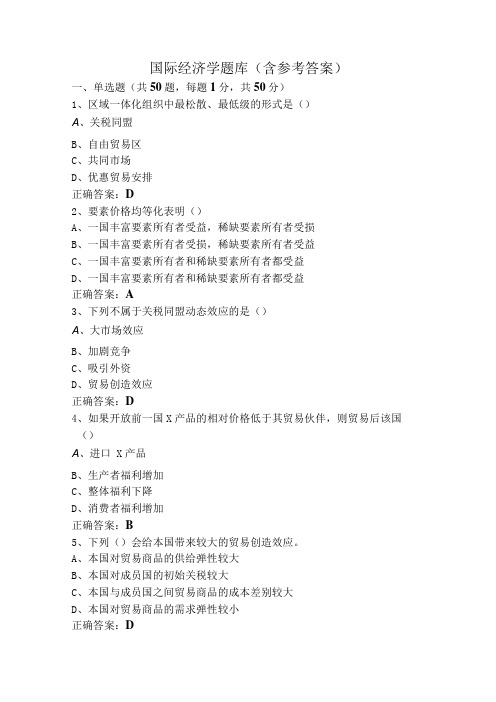
国际经济学题库(含参考答案)一、单选题(共50题,每题1分,共50分)1、区域一体化组织中最松散、最低级的形式是()A、关税同盟B、自由贸易区C、共同市场D、优惠贸易安排正确答案:D2、要素价格均等化表明()A、一国丰富要素所有者受益,稀缺要素所有者受损B、一国丰富要素所有者受损,稀缺要素所有者受益C、一国丰富要素所有者和稀缺要素所有者都受益D、一国丰富要素所有者和稀缺要素所有者都受益正确答案:A3、下列不属于关税同盟动态效应的是()A、大市场效应B、加剧竞争C、吸引外资D、贸易创造效应正确答案:D4、如果开放前一国X产品的相对价格低于其贸易伙伴,则贸易后该国()A、进口 X产品B、生产者福利增加C、整体福利下降D、消费者福利增加正确答案:B5、下列()会给本国带来较大的贸易创造效应。
A、本国对贸易商品的供给弹性较大B、本国对成员国的初始关税较大C、本国与成员国之间贸易商品的成本差别较大D、本国对贸易商品的需求弹性较小正确答案:D6、初级产品的出口价格若下降,其出口量将增加,出口总收入()A、不变B、增加C、下降D、不确定正确答案:C7、马歇尔一勒纳条件所要说明的是在供给弹性()的情况下,本币贬值能够改善贸易收支的进出口需求弹性条件。
A、零B、无穷大C、1D^大于零小于1正确答案:B8、假设中国和美国都能生产小麦和布,中国将一单位劳动时间全部生产布,可以生产50米;全部生产小麦,可以生产80千克;美国将一单位劳动时间全部生产布,可以生产40米;全部生产小麦,可以生产 100千克。
如果开放后的国际交换比价为1米布=L 8千克小麦,则下列说法正确的是()A、无法比较美国和中国的获利情况B、中国从贸易开放中获利更多C、美国和中国从贸易开放中获利相同D、美国从贸易开放中获利更多正确答案:D9、下列不属于国际收支平衡表资本项目的是()A、利息收支B、短期信贷C、短期证券买卖D、票据买卖正确答案:A10、消费者剩余是()A、消费者为了商品的消费而必须向政府支付的东西B、消费者通过低于市场价格的价格而得到的收益C、消费者购买商品所需支付的价格低于其愿意支付的价格而获得的收益D、消费者可以在各种价格水平得到的收益正确答案:C11、外汇市场中的即期交易不包含()A、套汇B、投机C、国际贸易结算D、银行同业拆借正确答案:B12、如果一个中国工人能生产3匹布或者1辆汽车,一个美国工人能生产4匹布或2辆汽车,则能促进中国与美国进行贸易并各自收益的交换比率是()A、4匹布换2辆汽车B、3匹布换1辆汽车C、3匹布换2辆汽车D、5匹布换2辆汽车正确答案:D13、国际经济学的研究对象是()A、国际商品流动B、国际收支平衡C、世界范围内的稀缺资源的最优配置D^国际人员流动正确答案:C14、根据国民收入决定方程Y=C+I+G+X-M,国际收支的吸收分析法中的“吸收”是指()A、YB、C+IC、C+I+GD、X-M正确答案:C15、开放经济条件下的宏观经济政策目标是()A、追求贸易顺差B、汇率稳定C、扩大出口D、国际收支平衡正确答案:D16、在进行贸易后,一国的收入分配会发生如下变化,()A、收入由消费者转向生产者B、受到进口商品竞争压力的国内生产者遭受损失,而出口商品的生产者则会受益C、消费者受损,生产者受益D、作为整体的国家受益,而个人则会受到损失正确答案:B17、商品和服务贸易记录在国际收支平衡表中的()A、经常项目B、误差和遗漏项目C、官方结算项目D、资本项目正确答案:A18、下列哪个行业最有可能具有内部规模经济?()A、好莱坞的电影业B、加州硅谷的半导体产业C、美国的大型农场D、北京中关村的电脑城正确答案:C19、采用()的配额分配方式,配额的福利效果与关税一样。
国际经济学试题-精选稿教师用-含部分答案-(最终)

国际经济学精选习题集第一局部国际贸易理论第1 章绪论一、单项选择题1.国际经济学在研究资源配置时,划分的底子经济单元是〔D〕A.企业 B. 个人 C. 当局 D. 国家2.国际经济学研究的对象是〔B〕A.国际商品流动C.国际出入平衡B. 世界范围内的稀缺资源的最优配置D. 国际人员流动3.从国际间经济资源流动的难易度看,流动最容易的是〔B〕A.商品 B. 本钱 C. 人员 D.技术二、判断阐发题1.国际经济学是成立在微不雅经济学与宏不雅经济学根底之上的一门分支科学。
√。
大局部国际经济学应用了宏微不雅经济学的一般道理,如无差别曲线、需求曲线、企业产量按照确定等,但是国际经济学理论本身也获得了许多理论性的进步。
在此根底上的国际经济学研究又鞭策了一般经济学理论研究方法的开展。
第2 章比拟优势道理一、单项选择题1.比拟优势理论认为,国际贸易的驱动力是〔A〕。
A.劳动出产率的差别B. 技术程度的差别C. 产物品质的差别D.价格的差别2.从15 世纪初到18 世纪中叶,在国际贸易和国际出入理论方面占主导地位的是〔A〕。
A.重商主义B. 重农主义C. 重金主义D. 自由放任主义3.绝对本钱学说是比拟本钱学说的〔C〕。
A.同一形式B. 开展形式C. 特殊形式D. 理论形式4.亚当·斯密的绝对优势理论认为〔C〕。
A.所有产物均具有绝对优势的国家最终将获得全部黄金和白银B.具有绝对优势的国家将获得大量贸易余额C.如果两个国家别离出口本国劳动本钱相对较低的产物,将同时从贸易中获益D.如果一国不消关税壁垒庇护本国财产将丧掉绝对优势5.李嘉图比拟优势理论指出〔B〕。
A.贸易导致不完全专业化B.即使一个国家不具备绝对本钱优势,也可从出口绝对本钱劣势相对较小的产物中获益C.与不具备绝对本钱优势的国家比拟,具有绝对本钱优势的国家可以从贸易中获利更多D.只有具备计较优势的国家才能获得贸易余额6.按照比拟本钱说,一国从国际贸易中获益的条件是〔B〕。
《国际经济学》篇章练习题及答案
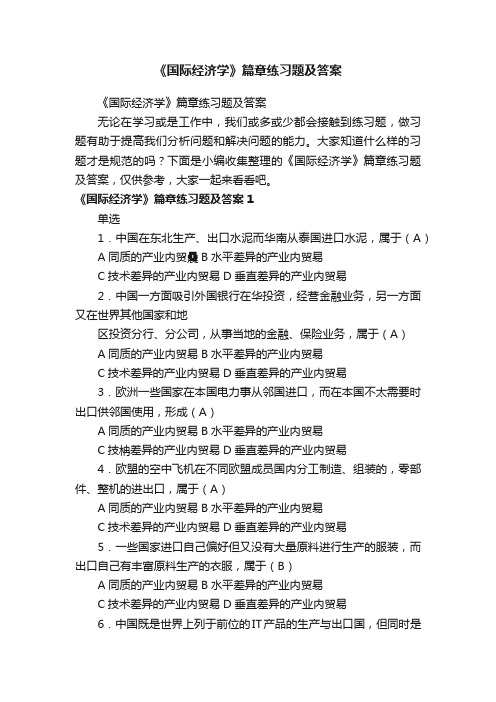
《国际经济学》篇章练习题及答案《国际经济学》篇章练习题及答案无论在学习或是工作中,我们或多或少都会接触到练习题,做习题有助于提高我们分析问题和解决问题的能力。
大家知道什么样的习题才是规范的吗?下面是小编收集整理的《国际经济学》篇章练习题及答案,仅供参考,大家一起来看看吧。
《国际经济学》篇章练习题及答案1单选1.中国在东北生产、出口水泥而华南从泰国进口水泥,属于(A)A同质的产业内贸曟B水平差异的产业内贸易C技术差异的产业内贸易D垂直差异的产业内贸易2.中国一方面吸引外国银行在华投资,经营金融业务,另一方面又在世界其他国家和地区投资分行、分公司,从事当地的金融、保险业务,属于(A)A同质的产业内贸易B水平差异的产业内贸易C技术差异的产业内贸易D垂直差异的产业内贸易3.欧洲一些国家在本国电力事从邻国进口,而在本国不太需要时出口供邻国使用,形成(A)A同质的产业内贸易B水平差异的产业内贸易C技柟差异的产业内贸易D垂直差异的产业内贸易4.欧盟的空中飞机在不同欧盟成员国内分工制造、组装的,零部件、整机的进出口,属于(A)A同质的产业内贸易B水平差异的产业内贸易C技术差异的产业内贸易D垂直差异的产业内贸易5.一些国家进口自己偏好但又没有大量原料进行生产的服装,而出口自己有丰富原料生产的衣服,属于(B)A同质的产业内贸易B水平差异的产业内贸易C技术差异的产业内贸易D垂直差异的产业内贸易6.中国既是世界上列于前位的IT产品的生产与出口国,但同时是高科技IT产品的进口国,属于(C)A同质的产业内贸易B水平差异的产业内贸易C技术差异的产业内贸易D垂直差异的产业内贸易7.发达国家在出口高档豪华车的同时,从其他发展中国家进口一些中、低质量的同类产品,属于(D)A同质的产业内贸易B水平差异的产业内贸易C技术差异的产业内贸易D垂直差异的产业内贸易8.新H-O模型解释的国际贸易类型是(D)A同质的产业内贸易B水平差异的产业内贸曟C技术差异的产业内贸易D垂直差异的产业内贸易9.克鲁格曼认为,产生产业内贸易的根本原因是(B)A差异产品的可选择性B规模经济C收入相似D经济发展水平相同10.林德需求重叠理论(B)。
安徽财经大学《国际经济学》模拟试卷13
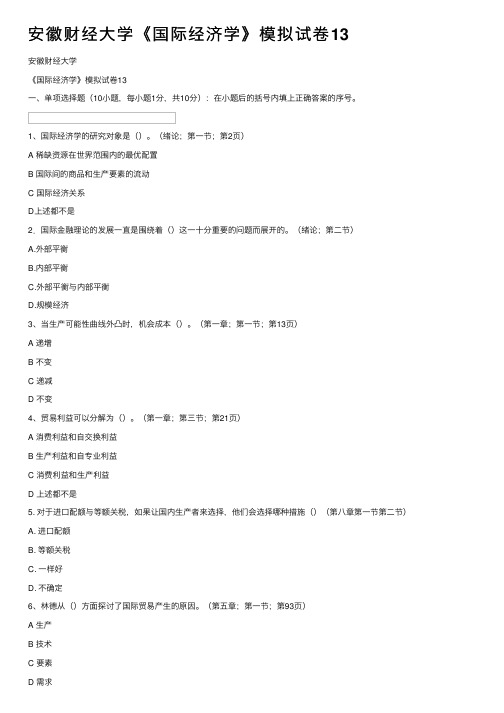
安徽财经⼤学《国际经济学》模拟试卷13安徽财经⼤学《国际经济学》模拟试卷13⼀、单项选择题(10⼩题,每⼩题1分,共10分):在⼩题后的括号内填上正确答案的序号。
1、国际经济学的研究对象是()。
(绪论;第⼀节;第2页)A 稀缺资源在世界范围内的最优配置B 国际间的商品和⽣产要素的流动C 国际经济关系D上述都不是2.国际⾦融理论的发展⼀直是围绕着()这⼀⼗分重要的问题⽽展开的。
(绪论;第⼆节)A.外部平衡B.内部平衡C.外部平衡与内部平衡D.规模经济3、当⽣产可能性曲线外凸时,机会成本()。
(第⼀章;第⼀节;第13页)A 递增B 不变C 递减D 不变4、贸易利益可以分解为()。
(第⼀章;第三节;第21页)A 消费利益和⾃交换利益B ⽣产利益和⾃专业利益C 消费利益和⽣产利益D 上述都不是5. 对于进⼝配额与等额关税,如果让国内⽣产者来选择,他们会选择哪种措施()(第⼋章第⼀节第⼆节)A. 进⼝配额B. 等额关税C. ⼀样好D. 不确定6、林德从()⽅⾯探讨了国际贸易产⽣的原因。
(第五章;第⼀节;第93页)A ⽣产B 技术C 要素D 需求7.属于国际收⽀账户中服务项⽬的有()。
(第⼗⼆章;第⼆节)A.证券投资B.商品修理C.计算机和信息服务D.⾮货币黄⾦8.购买⼒平价论(the theory of purchasing power parity),简称PPP理论,是()在其1922年出版的《1914年以后的货币与外汇》(money and foreign exchange after 1914)中第⼀次系统阐述的。
(第⼗四章;第⼆节)A.勒纳B.卡塞尔C.凯恩斯D.多恩布什9.假设即期汇率l英镑=2美元,在欧洲市场美元⼀年期的利率为15%,英镑为10%,求⼀年后的远期汇率1英镑等于()美元。
A.2.091B.2C.1.913D.310. 在直接标价法下,⼀定单位的外国货币折算的本国货币的数额增⼤,说明()币值上升,汇率()。
《国际经济学》期末考试试卷附答案
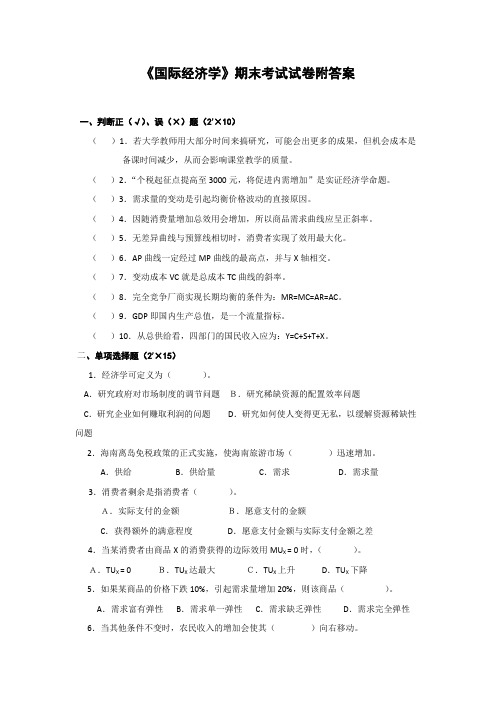
《国际经济学》期末考试试卷附答案一、判断正(√)、误(×)题(2’×10)()1.若大学教师用大部分时间来搞研究,可能会出更多的成果,但机会成本是备课时间减少,从而会影响课堂教学的质量。
()2.“个税起征点提高至3000元,将促进内需增加”是实证经济学命题。
()3.需求量的变动是引起均衡价格波动的直接原因。
()4.因随消费量增加总效用会增加,所以商品需求曲线应呈正斜率。
()5.无差异曲线与预算线相切时,消费者实现了效用最大化。
()6.AP曲线一定经过MP曲线的最高点,并与X轴相交。
()7.变动成本VC就是总成本TC曲线的斜率。
()8.完全竞争厂商实现长期均衡的条件为:MR=MC=AR=AC。
()9.GDP即国内生产总值,是一个流量指标。
()10.从总供给看,四部门的国民收入应为:Y=C+S+T+X。
二、单项选择题(2’×15)1.经济学可定义为()。
A.研究政府对市场制度的调节问题B.研究稀缺资源的配置效率问题C.研究企业如何赚取利润的问题D.研究如何使人变得更无私,以缓解资源稀缺性问题2.海南离岛免税政策的正式实施,使海南旅游市场()迅速增加。
A.供给B.供给量C.需求D.需求量3.消费者剩余是指消费者()。
A.实际支付的金额B.愿意支付的金额C.获得额外的满意程度D.愿意支付金额与实际支付金额之差4.当某消费者由商品X的消费获得的边际效用MU X = 0时,()。
A.TU X = 0 B.TU X达最大C.TU X上升D.TU X下降5.如果某商品的价格下跌10%,引起需求量增加20%,则该商品()。
A.需求富有弹性B.需求单一弹性C.需求缺乏弹性D.需求完全弹性6.当其他条件不变时,农民收入的增加会使其()向右移动。
A.预算线B.无差异曲线C.供给曲线D.边际收益曲线7.当单个可变要素的投入量处于合理区域时,必然有()。
A.TP开始下降B.MP开始上升C.AP≥MP D.AP≤MP8.在短期内,AC与AVC之间的垂直距离()。
【国际经济学专题考试试卷十三】The Costs of Production
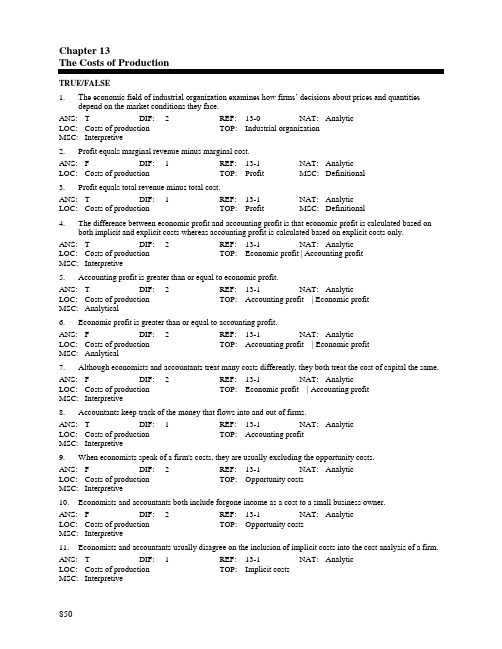
Chapter 13The Costs of ProductionTRUE/FALSE1. The economic field of industrial organization examines how firms’ decisions about prices and quantitiesdepend on the market conditions they face.ANS: T DIF: 2 REF: 13-0 NAT: AnalyticLOC: Costs of production TOP: Industrial organizationMSC: Interpretive2. Profit equals marginal revenue minus marginal cost.ANS: F DIF: 1 REF: 13-1 NAT: AnalyticLOC: Costs of production TOP: Profit MSC: Definitional3. Profit equals total revenue minus total cost.ANS: T DIF: 1 REF: 13-1 NAT: AnalyticLOC: Costs of production TOP: Profit MSC: Definitional4. The difference between economic profit and accounting profit is that economic profit is calculated based onboth implicit and explicit costs whereas accounting profit is calculated based on explicit costs only.ANS: T DIF: 2 REF: 13-1 NAT: AnalyticLOC: Costs of production TOP: Economic profit | Accounting profitMSC: Interpretive5. Accounting profit is greater than or equal to economic profit.ANS: T DIF: 2 REF: 13-1 NAT: AnalyticLOC: Costs of production TOP: Accounting profit | Economic profitMSC: Analytical6. Economic profit is greater than or equal to accounting profit.ANS: F DIF: 2 REF: 13-1 NAT: AnalyticLOC: Costs of production TOP: Accounting profit | Economic profitMSC: Analytical7. Although economists and accountants treat many costs differently, they both treat the cost of capital the same. ANS: F DIF: 2 REF: 13-1 NAT: AnalyticLOC: Costs of production TOP: Economic profit | Accounting profitMSC: Interpretive8. Accountants keep track of the money that flows into and out of firms.ANS: T DIF: 1 REF: 13-1 NAT: AnalyticLOC: Costs of production TOP: Accounting profitMSC: Interpretive9. When economists speak of a firm's costs, they are usually excluding the opportunity costs.ANS: F DIF: 2 REF: 13-1 NAT: AnalyticLOC: Costs of production TOP: Opportunity costsMSC: Interpretive10. Economists and accountants both include forgone income as a cost to a small business owner.ANS: F DIF: 2 REF: 13-1 NAT: AnalyticLOC: Costs of production TOP: Opportunity costsMSC: Interpretive11. Economists and accountants usually disagree on the inclusion of implicit costs into the cost analysis of a firm. ANS: T DIF: 1 REF: 13-1 NAT: AnalyticLOC: Costs of production TOP: Implicit costsMSC: Interpretive850Chapter 13/The Costs of Production 851 12. Implicit costs are costs that do not require an outlay of money by the firm.ANS: T DIF: 1 REF: 13-1 NAT: AnalyticLOC: Costs of production TOP: Implicit costsMSC: Definitional13. Accountants often ignore implicit costs.ANS: T DIF: 1 REF: 13-1 NAT: AnalyticLOC: Costs of production TOP: Implicit costsMSC: Interpretive14. In the long run, a factory is usually considered a fixed input.ANS: F DIF: 2 REF: 13-2 NAT: AnalyticLOC: Costs of production TOP: Long run MSC: Interpretive15. Diminishing marginal productivity implies decreasing total product.ANS: F DIF: 2 REF: 13-2 NAT: AnalyticLOC: Costs of production TOP: Diminishing marginal productMSC: Interpretive16. Diminishing marginal product exists when the total cost curve becomes flatter as outputs increases.ANS: F DIF: 2 REF: 13-2 NAT: AnalyticLOC: Costs of production TOP: Diminishing marginal productMSC: Interpretive17. Diminishing marginal product exists when the production function becomes flatter as inputs increase.ANS: T DIF: 2 REF: 13-2 NAT: AnalyticLOC: Costs of production TOP: Diminishing marginal productMSC: Interpretive18. A second or third worker may have a higher marginal product than the first worker in certain circumstances. ANS: T DIF: 2 REF: 13-2 NAT: AnalyticLOC: Costs of production TOP: Marginal productMSC: Interpretive19. The typical total-cost curve is U-shaped.ANS: F DIF: 2 REF: 13-2 NAT: AnalyticLOC: Costs of production TOP: Total-cost curveMSC: Interpretive20. The average fixed cost curve is constant.ANS: F DIF: 2 REF: 13-2 NAT: AnalyticLOC: Costs of production TOP: Average fixed costMSC: Interpretive21. In the short run, if a firm produces nothing, total costs are zero.ANS: F DIF: 2 REF: 13-2 NAT: AnalyticLOC: Costs of production TOP: Total costs | Fixed costsMSC: Interpretive22. If a firm produces nothing, it still incurs its fixed costs.ANS: T DIF: 2 REF: 13-2 NAT: AnalyticLOC: Costs of production TOP: Fixed costs MSC: Interpretive23. The shape of the total cost curve is unrelated to the shape of the production function.ANS: F DIF: 2 REF: 13-2 NAT: AnalyticLOC: Costs of production TOP: Total-cost curve | Production functionMSC: Interpretive852 Chapter 13/The Costs of Production24. The shape of the total cost curve is related to the shape of the production function.ANS: T DIF: 2 REF: 13-2 NAT: AnalyticLOC: Costs of production TOP: Total-cost curve | Production functionMSC: Interpretive25. If the marginal cost of producing the tenth unit of output is $3, and if the average total cost of producing thetenth unit of output is $2, then at ten units of output, average total cost is rising.ANS: T DIF: 3 REF: 13-3 NAT: AnalyticLOC: Costs of production TOP: Marginal cost | Average total costMSC: Analytical26. If the marginal cost of producing the tenth unit of output is $2.50, and if the average total cost of producing thetenth unit of output is $3, then at ten units of output, average total cost is rising.ANS: F DIF: 3 REF: 13-3 NAT: AnalyticLOC: Costs of production TOP: Marginal cost | Average total costMSC: Analytical27. If the marginal cost of producing the fifth unit of output is higher than the marginal cost of producing thefourth unit of output, then at five units of output, average total cost must be rising.ANS: F DIF: 3 REF: 13-3 NAT: AnalyticLOC: Costs of production TOP: Marginal cost | Average total costMSC: Analytical28. Marginal costs are costs that do not vary with the quantity of output produced.ANS: F DIF: 1 REF: 13-3 NAT: AnalyticLOC: Costs of production TOP: Marginal costMSC: Definitional29. Several related measures of cost can be derived from a firm's total cost.ANS: T DIF: 2 REF: 13-3 NAT: AnalyticLOC: Costs of production TOP: Cost curves MSC: Interpretive30. Variable costs usually change as the firm alters the quantity of output produced.ANS: T DIF: 2 REF: 13-3 NAT: AnalyticLOC: Costs of production TOP: Variable costsMSC: Definitional31. Variable costs equal fixed costs when nothing is produced.ANS: F DIF: 2 REF: 13-3 NAT: AnalyticLOC: Costs of production TOP: Variable costsMSC: Interpretive32. The cost of producing an additional unit of a good is not the same as the average cost of the good.ANS: T DIF: 2 REF: 13-3 NAT: AnalyticLOC: Costs of production TOP: Average total costMSC: Interpretive33. Average variable cost is equal to total variable cost divided by quantity of output.ANS: T DIF: 2 REF: 13-3 NAT: AnalyticLOC: Costs of production TOP: Average variable costMSC: Definitional34. The average total cost curve is unaffected by diminishing marginal product.ANS: F DIF: 3 REF: 13-3 NAT: AnalyticLOC: Costs of production TOP: Diminishing marginal product | Average total cost MSC: Interpretive35. The average total cost curve reflects the shape of both the average fixed cost and average variable cost curves. ANS: T DIF: 2 REF: 13-3 NAT: AnalyticLOC: Costs of production TOP: Average total costMSC: InterpretiveChapter 13/The Costs of Production 853 36. If the marginal cost curve is rising, then so is the average total cost curve.ANS: F DIF: 2 REF: 13-3 NAT: AnalyticLOC: Costs of production TOP: Marginal cost | Average total costMSC: Interpretive37. The marginal cost curve intersects the average total cost curve at the minimum point of the average total costcurve.ANS: T DIF: 2 REF: 13-3 NAT: AnalyticLOC: Costs of production TOP: Average total cost | Marginal costMSC: Interpretive38. The marginal cost curve intersects the average total cost curve at the minimum point of the marginal costcurve.ANS: F DIF: 2 REF: 13-3 NAT: AnalyticLOC: Costs of production TOP: Average total cost | Marginal costMSC: Interpretive39. Assume Jack received all A's in his classes last semester. If Jack gets all B's in his classes this semester, hisGPA may or may not fall.ANS: T DIF: 3 REF: 13-3 NAT: AnalyticLOC: Costs of production TOP: Average total costMSC: Interpretive40. Average total cost and marginal cost express information that is already contained in a firm's total cost. ANS: T DIF: 2 REF: 13-3 NAT: AnalyticLOC: Costs of production TOP: Average total costMSC: Interpretive41. Average total cost reveals how much total cost will change as the firm alters its level of production.ANS: F DIF: 2 REF: 13-3 NAT: AnalyticLOC: Costs of production TOP: Average total costMSC: Interpretive42. The shape of the marginal cost curve tells a producer something about the marginal product of her workers. ANS: T DIF: 2 REF: 13-3 NAT: AnalyticLOC: Costs of production TOP: Marginal cost | Marginal productMSC: Interpretive43. When average total cost rises if a producer either increases or decreases production, then the firm is said to beoperating at efficient scale.ANS: T DIF: 2 REF: 13-3 NAT: AnalyticLOC: Costs of production TOP: Efficient scaleMSC: Interpretive44. Fixed costs are those costs that remain fixed no matter how long the time horizon is.ANS: F DIF: 2 REF: 13-4 NAT: AnalyticLOC: Costs of production TOP: Fixed costs MSC: Interpretive45. Diseconomies of scale often arise because higher production levels allow specialization among workers. ANS: F DIF: 2 REF: 13-4 NAT: AnalyticLOC: Costs of production TOP: Diseconomies of scaleMSC: Interpretive46. Economies of scale often arise because higher production levels allow specialization among workers.ANS: T DIF: 2 REF: 13-4 NAT: AnalyticLOC: Costs of production TOP: Economies of scaleMSC: Interpretive854 Chapter 13/The Costs of Production47. If long-run average total cost is rising, then the firm is experiencing economies of scale.ANS: F DIF: 2 REF: 13-4 NAT: AnalyticLOC: Costs of production TOP: Economies of scale | Diseconomies of scaleMSC: Definitional48. The fact that many inputs are fixed in the short run but variable in the long run has little impact on the firm'scost curves.ANS: F DIF: 2 REF: 13-4 NAT: AnalyticLOC: Costs of production TOP: Long run MSC: Interpretive49. In some cases, specialization allows larger factories to produce goods at a lower average cost than smallerfactories.ANS: T DIF: 2 REF: 13-4 NAT: AnalyticLOC: Costs of production TOP: SpecializationMSC: Interpretive50. The use of specialization to achieve economies of scale is one reason modern societies are as prosperous asthey are.ANS: T DIF: 2 REF: 13-4 NAT: AnalyticLOC: Costs of production TOP: SpecializationMSC: Interpretive51. As a firm moves along its long-run average cost curve, it is adjusting the size of its factory to the quantity ofproduction.ANS: T DIF: 2 REF: 13-4 NAT: AnalyticLOC: Costs of production TOP: Average total costMSC: Interpretive52. Because of the greater flexibility that firms have in the long run, all short-run cost curves lie on or above thelong-run curve.ANS: T DIF: 2 REF: 13-4 NAT: AnalyticLOC: Costs of production TOP: Average total costMSC: Interpretive53. There is general agreement among economists that the long-run time period exceeds one year.ANS: F DIF: 2 REF: 13-4 NAT: AnalyticLOC: Costs of production TOP: Long run MSC: InterpretiveTable 13-1Listed in the table are the long-run total costs for three different firms.54. Refer to Table 13-1. Firm A is experiencing economies of scale.ANS: T DIF: 3 REF: 13-4 NAT: AnalyticLOC: Costs of production TOP: Economies of scaleMSC: Analytical55. Adam Smith's example of the pin factory demonstrates that economies of scale result from specialization. ANS: T DIF: 2 REF: 13-4 NAT: AnalyticLOC: Costs of production TOP: Economies of scaleMSC: InterpretiveChapter 13/The Costs of Production 855 SHORT ANSWER1. What are opportunity costs? How do explicit and implicit costs relate to opportunity costs?ANS:The opportunity cost of an item refers to all those things that must be forgone to acquire that item. Both explicit and implicit costs are included as opportunity costs.DIF: 2 REF: 13-1 NAT: Analytic LOC: Costs of productionTOP: Opportunity costs MSC: Definitional2. A key difference between accountants and economists is their different treatment of the cost of capital. Doesthis cause an accountant's estimate of total costs to be higher or lower than an economist's estimate? Explain. ANS:An accountant would not include the forgone interest income that the money could have earned elsewhere if it had not been invested in the business. Therefore, an accountant's estimate of total cost will be less than an economist's. DIF: 2 REF: 13-1 NAT: Analytic LOC: Costs of productionTOP: Economic profit | Accounting profit MSC: Analytical3. The production function depicts a relationship between which two variables? Also, draw a production functionthat exhibits diminishing marginal product.ANS:It depicts a relationship between output and a given input. The graph should show output increasing, but at a decreasing rate as inputs increase.DIF: 2 REF: 13-2 NAT: Analytic LOC: Costs of productionTOP: Production function MSC: Applicative856 Chapter 13/The Costs of Production4. How would a production function that exhibits decreasing marginal product affect the shape of the total costcurve? Explain or draw a graph.ANS:The total cost curve will increase at an increasing rate, or in other words, the total cost curve gets steeper as the amount produced rises.DIF: 2 REF: 13-3 NAT: Analytic LOC: Costs of productionTOP: Diminishing marginal product | Total-cost curve MSC: Analytical5. What effect, if any, does diminishing marginal product have on the shape of the marginal cost curve?ANS:Diminishing marginal product causes the marginal cost curve to rise.DIF: 2 REF: 13-3 NAT: Analytic LOC: Costs of productionTOP: Diminishing marginal product | Marginal cost MSC: Analytical6. Bob Edwards owns a bagel shop. Bob hires an economist who assesses the shape of the bagel shop's averagetotal cost (ATC) curve as a function of the number of bagels produced. The results indicate a U-shapedaverage total cost curve. Bob's economist explains that ATC is U-shaped for two reasons. The first is theexistence of diminishing marginal product, which causes it to rise. What would be the second reason? Assume that the marginal cost curve is linear. (Hint: The second reason relates to average fixed cost)ANS:Average fixed cost always declines as output rises because fixed cost is being spread over a larger number of units, thus causing the average total cost curve to fall.DIF: 3 REF: 13-3 NAT: Analytic LOC: Costs of productionTOP: Average total cost MSC: Analytical7. If the average total cost curve is falling, what is necessarily true of the marginal cost curve? If the average totalcost curve is rising, what is necessarily true of the marginal cost curve?ANS:When average total cost curve is falling, marginal cost is below ATC. If the average total cost curve is rising, marginal cost is above ATC.DIF: 2 REF: 13-3 NAT: Analytic LOC: Costs of productionTOP: Average total cost | Marginal cost MSC: Analytical8. According to the mathematical laws that govern the relationship between average total cost and marginal cost,where must these two curves intersect?ANS:The two curves will cross at the minimum point on the average total cost curve.DIF: 2 REF: 13-3 NAT: Analytic LOC: Costs of productionTOP: Average total cost | Marginal cost MSC: AnalyticalChapter 13/The Costs of Production 857 Sec00 - The Costs of ProductionMULTIPLE CHOICE1. Analyzing the behavior of the firm enhances our understanding ofa.what decisions lie behind the market supply curve.b.how consumers allocate their income to purchase scarce resources.c.how financial institutions set interest rates.d.whether resources are allocated fairly.ANS: A DIF: 1 REF: 13-0 NAT: AnalyticLOC: Costs of production TOP: Supply curveMSC: Applicative2. Which field of economics studies how the number of firms affects the prices in a market and the efficiency ofmarket outcomes?a.macro economicsb.industrial organizationbor economicsd.monetary economicsANS: B DIF: 1 REF: 13-0 NAT: AnalyticLOC: Costs of production TOP: Industrial organizationMSC: Definitional3. Economists in the field of industrial organization study howa.central banking policies affect financial markets.b.firms’ demand for labor and individuals’ supply of labor affect resource markets.c.firms’ decisions about prices and quantities depend on market conditions.d.externalities and public goods affect the environment.ANS: C DIF: 1 REF: 13-0 NAT: AnalyticLOC: Costs of production TOP: Industrial organizationMSC: Definitional4. Industrial organization is the study of howbor unions organize workers in industries.b.profitable firms are in organized industries.c.industries organize for political advantage.d.firms' decisions regarding prices and quantities depend on the market conditions they face.ANS: D DIF: 1 REF: 13-0 NAT: AnalyticLOC: Costs of production TOP: Industrial organizationMSC: Definitional5. To an economist, the field of industrial organization answers which of the following questions?a.Why are consumers subject to the law of demand?b.Why do firms experience diminishing marginal products of inputs?c.How does the number of firms affect prices and the efficiency of market outcomes?d.Why do firms consider production costs when determining product supply?ANS: C DIF: 1 REF: 13-0 NAT: AnalyticLOC: Costs of production TOP: Industrial organizationMSC: Definitional6. A student might describe information about the costs of production asa.dry and technical.b.boring.c.crucial to understanding firms and market structures.d.All of the above could be correct.ANS: D DIF: 1 REF: 13-0 NAT: AnalyticLOC: Costs of production TOP: Supply curveMSC: Interpretive858 Chapter 13/The Costs of ProductionSec01 - The Costs of Production - What Are Costs?MULTIPLE CHOICE1. Economists assume that the typical person who starts her own business does so with the intention ofa.donating the profits from her business to charity.b.capturing the highest number of sales in her industry.c.maximizing profits.d.minimizing costs.ANS: C DIF: 1 REF: 13-1 NAT: AnalyticLOC: Costs of production TOP: Profit maximizationMSC: Applicative2. Economists normally assume that the goal of a firm is to(i)sell as much of their product as possible.(ii)set the price of the product as high as possible.(iii)maximize profit.a.(i) and (ii) are true.b.(ii) and (iii) are true.c.(iii) is true.d.(i) and (iii) are true.ANS: C DIF: 2 REF: 13-1 NAT: AnalyticLOC: Costs of production TOP: Profit maximizationMSC: Interpretive3. Economists normally assume that the goal of a firm is to earn(i)profits as large as possible, even if it means reducing output.(ii)profits as large as possible, even if it means incurring a higher total cost.(iii)revenues as large as possible, even if it reduces profits.a.(i) and (ii) are true.b.(i) and (iii) are true.c.(ii) and (iii) are true.d.(i), (ii), and (iii) are true.ANS: A DIF: 2 REF: 13-1 NAT: AnalyticLOC: Costs of production TOP: Profit maximizationMSC: Interpretive4. A n entrepreneur’s motivation to start a business arises froma.an innate love for the type of business that he or she starts.b. a desire to earn a profit.c.an altruistic desire to provide the world with a good product.d.All of the above could be correct.ANS: D DIF: 2 REF: 13-1 NAT: AnalyticLOC: Costs of production TOP: Profit maximizationMSC: Interpretive5. Economists normally assume that the goal of a firm is toa.maximize its total revenue.b.maximize its profit.c.minimize its explicit costs.d.minimize its total cost.ANS: B DIF: 1 REF: 13-1 NAT: AnalyticLOC: Costs of production TOP: Profit maximizationMSC: DefinitionalChapter 13/The Costs of Production 8596. Economists assume that the goal of the firm is to maximize totala.revenue.b.profits.c.costs.d.satisfaction.ANS: B DIF: 1 REF: 13-1 NAT: AnalyticLOC: Costs of production TOP: Profit maximizationMSC: Interpretive7. When a firm is making a profit-maximizing production decision, which of the following principles ofeconomics is likely to be most important to the firm's decision?a.The cost of something is what you give up to get it.b. A country's standard of living depends on its ability to produce goods and services.c.Prices rise when the government prints too much money.ernments can sometimes improve market outcomes.ANS: A DIF: 2 REF: 13-1 NAT: AnalyticLOC: Costs of production TOP: Profit maximizationMSC: Interpretive8. The amount of money that a firm receives from the sale of its output is calleda.total gross profit.b.total net profit.c.total revenue. revenue.ANS: C DIF: 1 REF: 13-1 NAT: AnalyticLOC: Costs of production TOP: Total revenueMSC: Definitional9. Total revenue equalsa.price x quantity.b.price/quantity.c.(price x quantity) - total cost.d.output - input.ANS: A DIF: 1 REF: 13-1 NAT: AnalyticLOC: Costs of production TOP: Total revenueMSC: Definitional10. The amount of money that a firm pays to buy inputs is calleda.total cost.b.variable cost.c.marginal cost.d.fixed cost.ANS: A DIF: 2 REF: 13-1 NAT: AnalyticLOC: Costs of production TOP: Total cost MSC: Definitional11. Total cost is thea.amount a firm receives for the sale of its output.b.fixed cost less variable cost.c.market value of the inputs a firm uses in production.d.quantity of output minus the quantity of inputs used to make a good.ANS: C DIF: 2 REF: 13-1 NAT: AnalyticLOC: Costs of production TOP: Total cost MSC: Definitional12. Profit is defined as revenue minus depreciation.b.total revenue minus total cost.c.average revenue minus average total cost.d.marginal revenue minus marginal cost.ANS: B DIF: 1 REF: 13-1 NAT: AnalyticLOC: Costs of production TOP: Profit MSC: Definitional13. Profit is defined as total revenuea.plus total cost.b.times total cost.c.minus total cost.d.divided by total cost.ANS: C DIF: 1 REF: 13-1 NAT: AnalyticLOC: Costs of production TOP: Profit MSC: Definitional14. Which of the following can be added to profit to obtain total revenue? profitb.capital profitc.operational profitd.total costANS: D DIF: 2 REF: 13-1 NAT: AnalyticLOC: Costs of production TOP: Total revenueMSC: Analytical15. If Kelsey sells 300 glasses of lemonade at $0.50 each, her total revenues area.$150.b.$299.50.c.$300.d.$600.ANS: A DIF: 2 REF: 13-1 NAT: AnalyticLOC: Costs of production TOP: Total revenueMSC: Analytical16. If Amanda sells 200 glasses of lemonade at $0.50 each, her total revenues area.$100.b.$199.50.c.$200.d.$400.ANS: A DIF: 2 REF: 13-1 NAT: AnalyticLOC: Costs of production TOP: Total revenueMSC: Analytical17. Kirsten sells 300 glasses of lemonade at $0.50 each. Her total costs are $125. Her profits area.$25.b.$124.50.c.$125.d.$150.ANS: A DIF: 2 REF: 13-1 NAT: AnalyticLOC: Costs of production TOP: Profit MSC: Analytical18. Zoe sells 200 glasses of lemonade at $0.50 each. Her total costs are $25. Her profits area.$25.b.$75.c.$100.d.$175.ANS: B DIF: 2 REF: 13-1 NAT: AnalyticLOC: Costs of production TOP: Profit MSC: Analytical19. XYZ corporation produced 300 units of output but sold only 275 of the units it produced. The average cost ofproduction for each unit of output produced was $100. Each of the 275 units sold was sold for a price of $95.Total profit for the XYZ corporation would bea.-$3,875.b.$26,125.c.$28,500.d.$30,000.ANS: A DIF: 2 REF: 13-1 NAT: AnalyticLOC: Costs of production TOP: Profit MSC: Applicative20. Those things that must be forgone to acquire a good are calleda.implicit costs.b.opportunity costs.c.explicit costs.d.accounting costs.ANS: B DIF: 1 REF: 13-1 NAT: AnalyticLOC: Costs of production TOP: Opportunity costMSC: Definitional21. Gordon is a senior majoring in computer network development at Smart State University. While he has beenattending college, Gordon started a computer consulting business to help senior citizens set up their network connections and teach them how to use e-mail. Gordon charges $25 per hour for his consulting services.Gordon also works 5 hours a week for the Economics Department to maintain that department's Web page.The Economics Department pays Gordon $20 per hour. From this information we can conclude:a.Gordon should increase the number of hours he works for the Economics Department to make itcomparable to his consulting business income.b.Gordon is obviously not maximizing his well-being if he continues to work for the EconomicsDepartment.c.If Gordon chooses one hour at the beach with his friends rather than spend one more hour with aconsulting client, the forgone income of $25 is considered a cost of the choice to go to the beach.d.Both b and c are correctANS: C DIF: 2 REF: 13-1 NAT: AnalyticLOC: Costs of production TOP: Opportunity costMSC: Analytical22. A firm's opportunity costs of production are equal to itsa.explicit costs only.b.implicit costs only.c.explicit costs + implicit costs.d.explicit costs + implicit costs + total revenue.ANS: C DIF: 1 REF: 13-1 NAT: AnalyticLOC: Costs of production TOP: Opportunity costMSC: Definitional23. Susan used to work as a telemarketer, earning $25,000 per year. She gave up that job to start a cateringbusiness. In calculating the economic profit of her catering business, the $25,000 income that she gave up is counted as part of the catering firm'sa.total revenue.b.opportunity costs.c.explicit costs.d.marginal costs.ANS: B DIF: 1 REF: 13-1 NAT: AnalyticLOC: Costs of production TOP: Opportunity costMSC: Interpretive24. John has decided to start his own lawn-mowing business. To purchase the mowers and the trailer to transportthe mowers, John withdrew $1,000 from his savings account, which was earning 3% interest, and borrowed an additional $2,000 from the bank at an interest rate of 7%. What is John's annual opportunity cost of thefinancial capital that has been invested in the business?a.$30b.$140c.$170d.$300ANS: C DIF: 3 REF: 13-1 NAT: AnalyticLOC: Costs of production TOP: Opportunity costMSC: Analytical25. Gavin has decided to start his own snow removal business. To purchase the necessary equipment, Gavinwithdrew $2,000 from his savings account, which was earning 3% interest, and borrowed an additional $4,000 from the bank at an interest rate of 7%. What is Gavin's annual opportunity cost of the financial capital that has been invested in the business?a.$60b.$280c.$340d.$660ANS: C DIF: 2 REF: 13-1 NAT: AnalyticLOC: Costs of production TOP: Opportunity costMSC: Analytical26. Dianne has decided to start her own photography studio. To purchase the necessary equipment, Diannewithdrew $10,000 from her savings account, which was earning 3% interest, and borrowed an additional$5,000 from the bank at an interest rate of 8%. What is Dianne's annual opportunity cost of the financialcapital that has been invested in the business?a.$300b.$400c.$700d.$1,650ANS: C DIF: 2 REF: 13-1 NAT: AnalyticLOC: Costs of production TOP: Opportunity costMSC: Analytical27. The value of a business owner's time is an example ofa.an opportunity cost.b. a fixed cost.c.an explicit cost.d.total revenue.ANS: A DIF: 1 REF: 13-1 NAT: AnalyticLOC: Costs of production TOP: Opportunity costMSC: Interpretive28. An example of an opportunity cost that is also an implicit cost isa. a lease payment.b.the cost of raw materials.c.the value of the business owner’s time.d.All of the above are correct.ANS: C DIF: 1 REF: 13-1 NAT: AnalyticLOC: Costs of production TOP: Opportunity costMSC: Interpretive。
国际经济学第13章在线测试
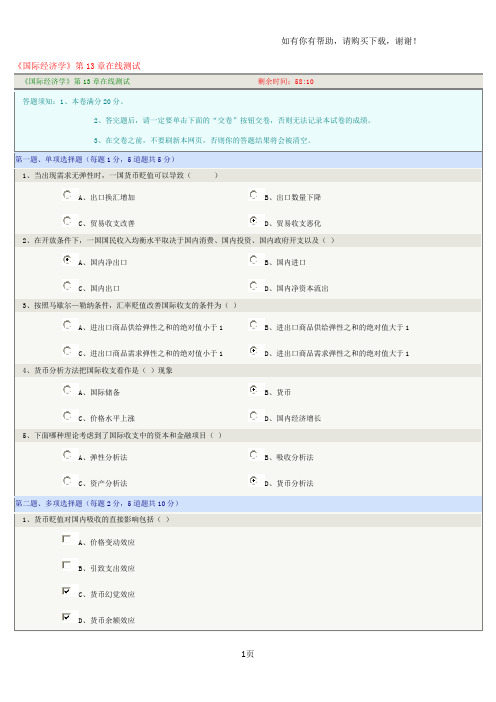
《国际经济学》第13章在线测试《国际经济学》第13章在线测试剩余时间:58:10答题须知:1、本卷满分20分。
2、答完题后,请一定要单击下面的“交卷”按钮交卷,否则无法记录本试卷的成绩。
3、在交卷之前,不要刷新本网页,否则你的答题结果将会被清空。
第一题、单项选择题(每题1分,5道题共5分)1、当出现需求无弹性时,一国货币贬值可以导致()A、出口换汇增加B、出口数量下降C、贸易收支改善D、贸易收支恶化2、在开放条件下,一国国民收入均衡水平取决于国内消费、国内投资、国内政府开支以及()A、国内净出口B、国内进口C、国内出口D、国内净资本流出3、按照马歇尔—勒纳条件,汇率贬值改善国际收支的条件为()A、进出口商品供给弹性之和的绝对值小于1B、进出口商品供给弹性之和的绝对值大于1C、进出口商品需求弹性之和的绝对值小于1D、进出口商品需求弹性之和的绝对值大于14、货币分析方法把国际收支看作是()现象A、国际储备B、货币C、价格水平上涨D、国内经济增长5、下面哪种理论考虑到了国际收支中的资本和金融项目()A、弹性分析法B、吸收分析法C、资产分析法D、货币分析法第二题、多项选择题(每题2分,5道题共10分)1、货币贬值对国内吸收的直接影响包括()A、价格变动效应B、引致支出效应C、货币幻觉效应D、货币余额效应E、收入再分配效应2、一个国家的总吸收包括()A、政府购买B、净出口C、出口D、消费E、投资3、J曲线产生的原因包括()A、交货时滞B、生产时滞C、取代时滞D、决策时滞E、认识时滞4、根据货币分析法,减少一个国家国际收支赤字的方法包括()A、提高货币供给增长率B、降低货币供给增长率C、采取紧缩性的货币政策D、采取扩张性的货币政策E、货币贬值5、下面关于吸收分析法的说法正确的有()A、当吸收增加大于产出增加时,国际收支改善B、当吸收增加小于产出增加时,国际收支改善C、当吸收增加时,国际收支改善D、当吸收大于产出时国际收支顺差正确错误、一国的货币贬值后,只要满足条件,能立即改善国际收支状况。
《国际经济学》期末试卷5套
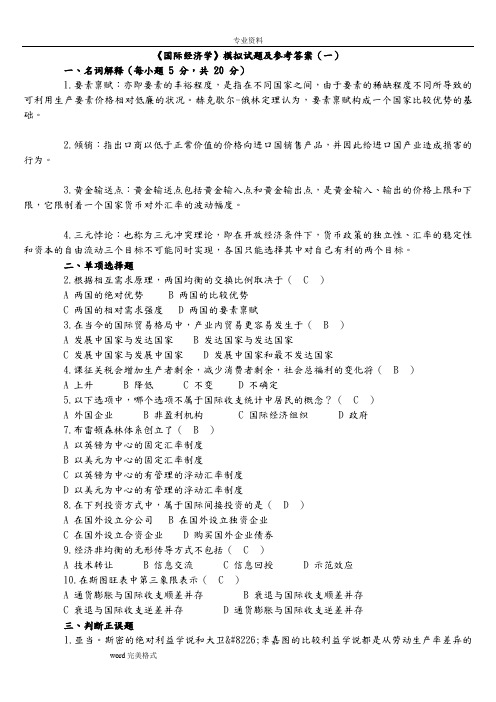
《国际经济学》模拟试题及参考答案(一)一、名词解释(每小题 5 分,共 20 分)1.要素禀赋:亦即要素的丰裕程度,是指在不同国家之间,由于要素的稀缺程度不同所导致的可利用生产要素价格相对低廉的状况。
赫克歇尔-俄林定理认为,要素禀赋构成一个国家比较优势的基础。
2.倾销:指出口商以低于正常价值的价格向进口国销售产品,并因此给进口国产业造成损害的行为。
3.黄金输送点:黄金输送点包括黄金输入点和黄金输出点,是黄金输入、输出的价格上限和下限,它限制着一个国家货币对外汇率的波动幅度。
4.三元悖论:也称为三元冲突理论,即在开放经济条件下,货币政策的独立性、汇率的稳定性和资本的自由流动三个目标不可能同时实现,各国只能选择其中对自己有利的两个目标。
二、单项选择题2.根据相互需求原理,两国均衡的交换比例取决于( C )A 两国的绝对优势B 两国的比较优势C 两国的相对需求强度D 两国的要素禀赋3.在当今的国际贸易格局中,产业内贸易更容易发生于( B )A 发展中国家与发达国家B 发达国家与发达国家C 发展中国家与发展中国家D 发展中国家和最不发达国家4.课征关税会增加生产者剩余,减少消费者剩余,社会总福利的变化将( B )A 上升B 降低C 不变D 不确定5.以下选项中,哪个选项不属于国际收支统计中居民的概念?( C )A 外国企业B 非盈利机构C 国际经济组织D 政府7.布雷顿森林体系创立了( B )A 以英镑为中心的固定汇率制度B 以美元为中心的固定汇率制度C 以英镑为中心的有管理的浮动汇率制度D 以美元为中心的有管理的浮动汇率制度8.在下列投资方式中,属于国际间接投资的是( D )A 在国外设立分公司B 在国外设立独资企业C 在国外设立合资企业D 购买国外企业债券9.经济非均衡的无形传导方式不包括( C )A 技术转让B 信息交流C 信息回授D 示范效应10.在斯图旺表中第三象限表示( C )A 通货膨胀与国际收支顺差并存B 衰退与国际收支顺差并存C 衰退与国际收支逆差并存D 通货膨胀与国际收支逆差并存三、判断正误题1.亚当。
中国大学mooc《国际经济学(首都经济贸易大学) 》满分章节测试答案
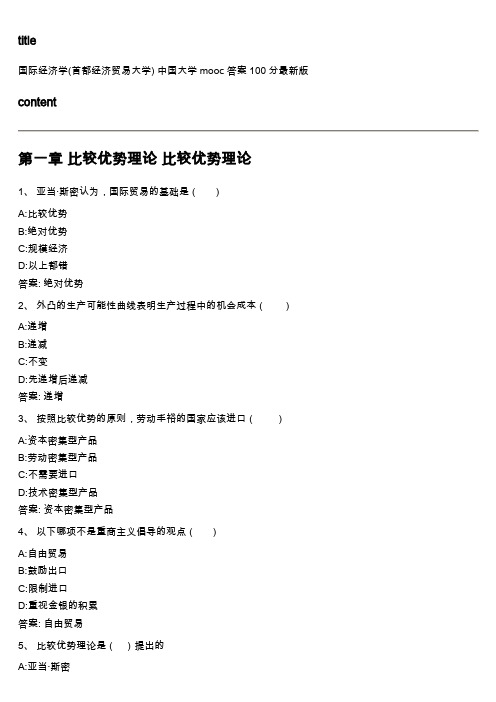
title国际经济学(首都经济贸易大学) 中国大学mooc答案100分最新版content第一章比较优势理论比较优势理论1、亚当·斯密认为,国际贸易的基础是()A:比较优势B:绝对优势C:规模经济D:以上都错答案: 绝对优势2、外凸的生产可能性曲线表明生产过程中的机会成本()A:递增B:递减C:不变D:先递增后递减答案: 递增3、按照比较优势的原则,劳动丰裕的国家应该进口()A:资本密集型产品B:劳动密集型产品C:不需要进口D:技术密集型产品答案: 资本密集型产品4、以下哪项不是重商主义倡导的观点()A:自由贸易B:鼓励出口C:限制进口D:重视金银的积累答案: 自由贸易5、比较优势理论是()提出的A:亚当·斯密B:大卫·李嘉图C:凯恩斯D:克鲁格曼答案: 大卫·李嘉图6、如果国家A每1单位劳动时间可以生产3单位X或者3单位Y,国家B每1单位劳动时间可以生产1单位X或者3单位Y,那么()A:国家A在生产X上具有比较劣势B:国家B在生产Y上具有比较劣势C:国家A在生产X上具有比较优势D:国家A在任何产品生产上都不具有比较优势答案: 国家A在生产X上具有比较优势7、李嘉图解释比较优势理论的基础是()A:劳动价值论B:机会成本理论C:规模报酬递减D:以上都正确答案: 劳动价值论8、两个国家相对产品价格的差异可能是基于()A:要素禀赋的差异B:技术的差异C:消费者偏好的差异D:以上都正确答案: 以上都正确9、假定机会成本不变,大国和小国进行贸易()A:大国可能获得全部贸易利益B:小国可能获得全部贸易利益C:大国和小国平分贸易利益D:以上都不正确答案: 小国可能获得全部贸易利益10、如果国家A每1单位劳动时间可以生产3单位X或者3单位Y,国家B每1单位劳动时间可以生产1单位X或者3单位Y,如果国家A拿3单位X交换3单位Y,那么()A:国家A获利2单位XB:国家B获利6单位YC:国家A获利3单位YD:国家B获利3单位Y答案: 国家B获利6单位Y11、李嘉图解释比较理论的基础是()A:劳动价值论B:机会成本理论C:规模报酬递减D:以上都正确答案: 劳动价值论12、假定机会成本不变,大国和小国进行贸易:()A:大国可能获得全部贸易利益B:小国可能获得全部贸易利益C:大国和小国平分贸易利益D:以上都不正确答案: 以上都不正确作业第一章比较优势理论比较优势理论1、请简要阐述重商主义的主要观点。
国际经济学试题与答案
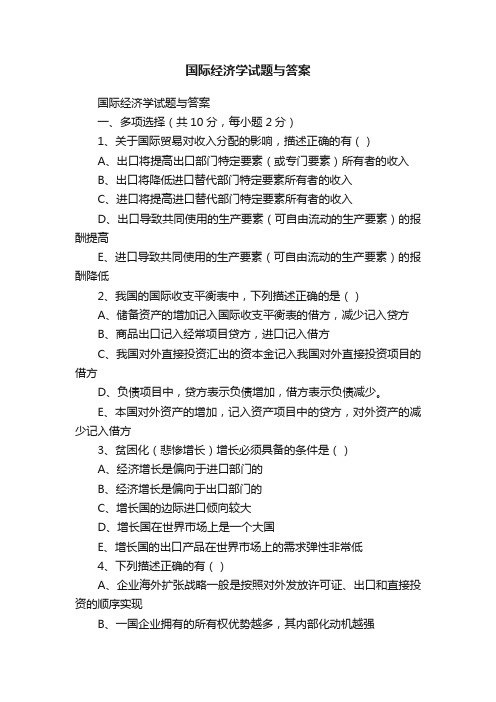
国际经济学试题与答案国际经济学试题与答案一、多项选择(共10分,每小题2分)1、关于国际贸易对收入分配的影响,描述正确的有()A、出口将提高出口部门特定要素(或专门要素)所有者的收入B、出口将降低进口替代部门特定要素所有者的收入C、进口将提高进口替代部门特定要素所有者的收入D、出口导致共同使用的生产要素(可自由流动的生产要素)的报酬提高E、进口导致共同使用的生产要素(可自由流动的生产要素)的报酬降低2、我国的国际收支平衡表中,下列描述正确的是()A、储备资产的增加记入国际收支平衡表的借方,减少记入贷方B、商品出口记入经常项目贷方,进口记入借方C、我国对外直接投资汇出的资本金记入我国对外直接投资项目的借方D、负债项目中,贷方表示负债增加,借方表示负债减少。
E、本国对外资产的增加,记入资产项目中的贷方,对外资产的减少记入借方3、贫困化(悲惨增长)增长必须具备的条件是()A、经济增长是偏向于进口部门的B、经济增长是偏向于出口部门的C、增长国的边际进口倾向较大D、增长国在世界市场上是一个大国E、增长国的出口产品在世界市场上的需求弹性非常低4、下列描述正确的有()A、企业海外扩张战略一般是按照对外发放许可证、出口和直接投资的顺序实现B、一国企业拥有的所有权优势越多,其内部化动机越强A—7—1C、本国的区位优势越明显,本国对外直接投资的动机就越强D、降低无形资产交易成本的最好方法不是发放许可证,而是直接投资E、企业特有优势与国家特有优势紧密相联5、下列关于关税同盟的说法正确的有()A、关税同盟成立前后,成员国的贸易方向可能会发生转移B、关税同盟具有歧视性和排他性,有可能导致新的垄断C、原产地规则是关税同盟成员国经常采用的一项规则D、关税同盟的建立促进了成员国之间的竞争,有利于技术进步和经济效率的提高E、关税同盟有助于市场扩大,从而有利于规模经济的形成二、单项选择(共30分,每小题1分)1、国际经济学的研究对象是()A、商品和要素在国际间的流动B、汇率决定C、国际收支平衡D、世界范围内的稀缺资源配置2、下列一体化程度最低和最高的两种一体化形式分别是()A、自由贸易区和完全的经济一体化B、关税同盟和完全的经济一体化C、关税同盟和共同市场D、自由贸易区和经济联盟3、下列不属于贸易保护学说的理论是()A、幼稚产业学说C、最佳关税学说B、资源禀赋学说D、抽取垄断租金论4、下列不属于关税同盟的动态效果的是()A、市场扩大或规模经济效果B、贸易创造和贸易转移效果C、吸引外部投资D、促进成员国企业竞争5、关于倾销的说法正确的有()A、持续性倾销是出口商以低于其本国国内价格甚至是低于其生产成本的价格长期向国外销售其产品的行为A—7—2B、掠夺性倾销是出口商以低于其本国国内价格甚至是低于其生产成本的价格向国外销售其产品的暂时性行为C、倾销不利于进口国相关产品的消费者D、倾销不利于出口国相关产品的生产者6、下列说法正确的有()A、出口补贴对出口国的生产者不利,对进口国的消费者不利B、出口补贴对出口国的生产者有利,对出口国的消费者也有利C、出口补贴对进口国的生产者不利,对进口国的消费者也不利D、出口补贴对出口国的生产者有利,对进口国的消费者有利7、在产品生命周期的初始阶段,该产品一般属于()A、资本密集型产品B、劳动密集型产品C、技术密集型产品D、资源密集型产品8、下列那个因素不会导致国际贸易()A、两国需求状况相同时,要素禀赋的相对差异B、两国需求状况相同时,要素禀赋无相对差异差异,但有绝对差异C、供给状况相同时,需求状况的差异D、其他条件相同时,两国生产率的相对差异9、关于国际贸易中的国际交换比价和国际贸易利益,下列说法不正确的有()A、只要国际交换比价处在开放前两国国内交换比价之间,则国际贸易就可能进行B、只要国际交换比价处在开放前两国国内交换比价之间,则国际贸易对两个国家都有好处C、只要国际交换比价处在开放前两国国内交换比价之间,则国际贸易给两个国家带来的好处就相等D、只要国际交换比价处在开放前两国国内交换比价之间,则国际贸易就可增加世界总福利10、根据要素禀赋理论中的有关定理,下列论述不正确的有()A、进口关税将提高进口竞争商品密集使用的生产要素的实际报酬B、进口关税将降低出口部门密集使用的生产要素的实际报酬C、商品的出口将提高出口部门密集使用的生产要素的实际报酬D、商品的进口将提高进口竞争商品密集使用的生产要素的实际报酬A—7—311、根据要素价格均等化原理,下列那个不是要素价格均等化的真正原因()A、商品价格未实现均等化B、关税、非关税壁垒等障碍C、运输成本的存在D、要素在国家之间的流动受到限制12、根据罗伯津斯基(雷布任斯基)定理,下列那个推论是正确的()A、偏向出口部门的增长将改善本国的贸易条件B、偏向进口部门的增长将恶化本国的贸易条件C、偏向进口部门的增长将降低本国的福利D、偏向出口部门的增长在一定条件下可能会降低本国的净福利13、关于汇率,下列表述正确的是()A、汇率上升,则本币贬值B、汇率下降,则本币贬值C、直接标价法下,汇率上升,则本币升值D、间接标价法下,汇率上升,则本币升值14、在供给弹性无穷大的情况下,马歇尔和勒纳认为,通过本币贬值改善贸易收支,必须具备的条件是什么?其中,ηx,ηm分别是出口和进口需求弹性()A、|ηx-ηm |<1B、|ηx+ηm |>1C、|ηx+ηm |<1D、|ηx-ηm |>115、给定边际消费倾向为4/5,边际进口倾向为1/10,则外贸乘数为()A、10/2B、10/19C、10/9D、10/1716、假定某国关税前单位棉布的市场价格为10元,其中间投入品棉纱的市场价格为6元,若该国对棉布征收进口关税税率为20%,对棉纱的关税税为40%,则该国对棉布的实际保护率为()A、10%B、-10%C、90%D、-90%17、根据国际收支调整的货币分析方法,下列表述正确的是()(1)在货币需求不变的情况下,国内信贷减少,则国际收支会出现顺差(2)在货币需求不变的情况下,国内信贷减少,则国际收支会出现逆差(3)在货币需求不变的情况下,国内信贷扩张,则国际收支会出现顺差(4)在货币需求不变的情况下,国内信贷扩张,则国际收支会出现逆差A—7—4A、1和4都正确B、2和3都正确C、只有1正确D、只有2正确18、关于利率平价,下列表述正确的有()A、国内利率高于国外利率引起的套利活动将导致本币贬值B、国内利率高于国外利率则人们会预期本币会升值C、抛补利率平价条件意味着,远期汇率等于预期未来的即期汇率D、利率平价是“一价定律”在商品市场(可贸易品)发挥作用的结果19、关于购买力平价,下列表述正确的是()A、PPP学说是一价定律在某个具体商品上的体现B、若一定时期内外国的通货膨胀率高于本国,则以间接标价法表示的汇率上升C、金铸币本位制下,汇率的波动范围的下限是金平价加上黄金运送成本D、一价定律的前提条件是不完全竞争的市场机制20、当一国国际收支为顺差时,外汇市场上本币的供求关系为()A、供大于求B、供小于求C、供求相等D、无法判断21、由于国际市场上制成品价格大幅度上升,初级产品价格增长缓慢导致的发展中国家贸易条件恶化和国际收支不平衡,属于()A、周期性不平衡B、结构性不平衡C、收入性不平衡D、价格性不平衡22、下列不属于金铸币本位制的基本特征的有()A、以金币为本位币B、金币自由铸造C、黄金自由输入和输出D、发行纸币23、根据蒙代尔提出的“分配法则”,外部平衡应该采取什么政策来实现()A、货币政策B、财政政策C、产业政策D、国别政策24、固定汇率制下,某国出现了高失业和国际收支逆差并存的情况,则应该采用()A、紧缩性的财政政策与扩张性的货币政策B、紧缩性的财政政策与紧缩性的货币政策C、扩张性的财政政策与紧缩性的货币政策D、扩张性的财政政策与扩张性的货币政策A—7—525、布雷顿森林体系是以()为中心的国际货币体系。
厦大《国际经济学》课程试卷试卷答案(三套).doc
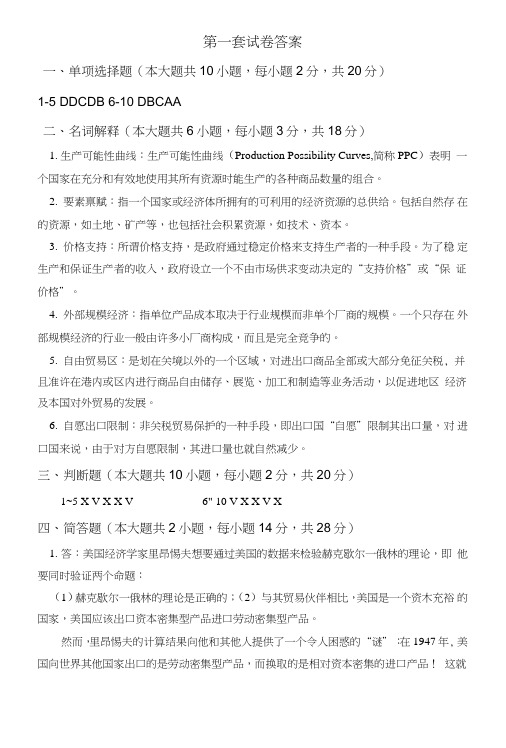
第一套试卷答案一、单项选择题(本大题共10小题,每小题2分,共20分)1-5 DDCDB 6-10 DBCAA二、名词解释(本大题共6小题,每小题3分,共18分)1.生产可能性曲线:生产可能性曲线(Production Possibility Curves,简称PPC)表明一个国家在充分和有效地使用其所有资源时能生产的各种商品数量的组合。
2.要素禀赋:指一个国家或经济体所拥有的可利用的经济资源的总供给。
包括自然存在的资源,如土地、矿产等,也包括社会积累资源,如技术、资本。
3.价格支持:所谓价格支持,是政府通过稳定价格来支持生产者的一种手段。
为了稳定生产和保证生产者的收入,政府设立一个不由市场供求变动决定的“支持价格”或“保证价格”。
4.外部规模经济:指单位产品成本取决于行业规模而非单个厂商的规模。
一个只存在外部规模经济的行业一般由许多小厂商构成,而且是完全竞争的。
5.自由贸易区:是划在关境以外的一个区域,对进岀口商品全部或大部分免征关税, 并且准许在港内或区内进行商品自由储存、展览、加工和制造等业务活动,以促进地区经济及本国对外贸易的发展。
6.自愿岀口限制:非关税贸易保护的一种手段,即出口国“自愿”限制其出口量,对进口国来说,由于对方自愿限制,其进口量也就自然减少。
三、判断题(本大题共10小题,每小题2分,共20分)1~5 X V X X V 6" 10 V X X V X四、简答题(本大题共2小题,每小题14分,共28分)1.答:美国经济学家里昂惕夫想要通过美国的数据来检验赫克歇尔一俄林的理论,即他要同时验证两个命题:(1)赫克歇尔一俄林的理论是正确的;(2)与其贸易伙伴相比,美国是一个资木充裕的国家,美国应该岀口资本密集型产品进口劳动密集型产品。
然而,里昂惕夫的计算结果向他和其他人提供了一个令人困惑的“谜”:在1947年, 美国向世界其他国家出口的是劳动密集型产品,而换取的是相对资本密集的进口产品!这就是里昂惕夫之谜.理论上对里昂惕夫之谜的解释包括(1)生产要素密集性逆转,例如在美国由于资 本充裕而劳动相对稀缺,资本便宜和劳动力昂贵,美国可能在玩具生产中使用更多的资 本而非劳动。
国际经济学试题及答案
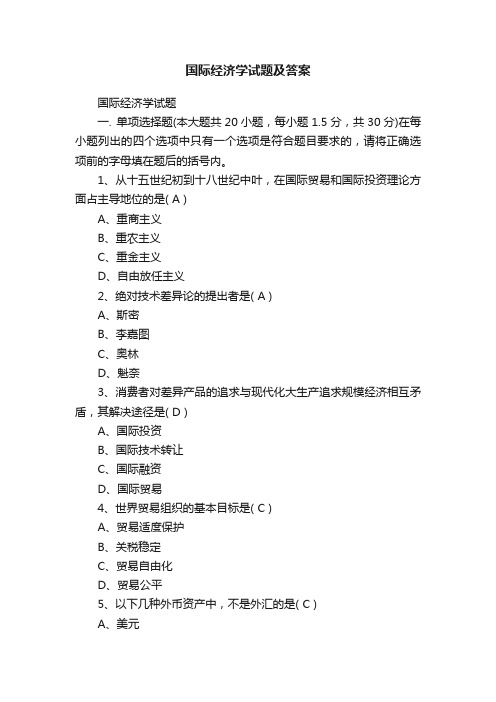
国际经济学试题及答案国际经济学试题一. 单项选择题(本大题共20小题,每小题1.5分,共30分)在每小题列出的四个选项中只有一个选项是符合题目要求的,请将正确选项前的字母填在题后的括号内。
1、从十五世纪初到十八世纪中叶,在国际贸易和国际投资理论方面占主导地位的是( A )A、重商主义B、重农主义C、重金主义D、自由放任主义2、绝对技术差异论的提出者是( A )A、斯密B、李嘉图C、奥林D、魁奈3、消费者对差异产品的追求与现代化大生产追求规模经济相互矛盾,其解决途径是( D )A、国际投资B、国际技术转让C、国际融资D、国际贸易4、世界贸易组织的基本目标是( C )A、贸易适度保护B、关税稳定C、贸易自由化D、贸易公平5、以下几种外币资产中,不是外汇的是( C )A、美元B、英镑C、港元D、越南盾6、在发展中国家利用外资的主要渠道中,不需要偿还的引资方式是( D )A、官方贷款B、发行债券C、银行贷款D、外商直接投资7、在下列投资方式中,属于国际直接投资的是(D)A.购买外国政府债券B.购买外国企业债券C.向外国企业提供商业贷款D.在国外开设合资企业8、赫克歇尔一俄林模型认为国际贸易的根本原因是(A)A.各国生产要素禀赋不同B.各国劳动生产率不同C.各国技术水平不同以D.各国产品技术含量不同9、属于非关税壁垒的措施是(D)A.反倾销税B.反补贴税C.进口附加税D.国内最低限价10、在比较利益模型中,两种参与贸易商品的国际比价( C)A.在两国贸易前的两种商品的国内比价之上B.在两国贸易前的两种商品的国内比价之下C.在两国贸易前的两种商品的国内比价之间D.与贸易前的任何一个国家的国内比价相同11、比较利益理论认为国际贸易的驱动力是(A )A.劳动生产率的差异B.技术水平的差异C.产品品质的差异D.价格的差异12、在绝对技术差异理论与相对技术差异理论中,机会成本是(D )A.递增B.递减C.先递增后递减D.不变13、不能解释产业内贸易现象的理论有(B )A.重叠需求理论B.要素比例理论B.规模经济理论 D.垄断竞争理论14、能反映规模经济理论本意的是(B )A.规模报酬递减B.规模报酬递增C.规模报酬不变D.规模成本递增15、下列不属于保护贸易学说的理论有(D )A.幼稚工业理论B.夕阳工业理论C.国防论D.资源禀赋论16、最佳关税水平应等于(B )A.零进口关税B.零进口关税与禁止性关税之间的水平C.禁止性关税D.禁止性关税以上17、下述哪一种不属于投机性外汇交易(D )A.双边套汇B.多边套汇C.套利D.套期保值18、下述几种货币中,哪一种是实行联合浮动的货币( D)A.英镑B.日元C.美元D.人民币19、劳动力在各国间的流动通常会使劳动力流入国( A)A.财政总收入增加,公共设施利用率提高B.财政总收入增加,公共设施利用率下降C.财政总收入减少,公共设施利用率提高D.财政总收入减少,公共设施利用率下降20、下述哪一种属于国际收支的事后项目(D )A.进出口B.利息收支C.直接投资D.特别提款权变动二、多项选择题(本大题共5小题,每小题3分,共15分)在每小题列出的五个选项中有二至五个选项是符合题目要求的,请将正确选项前的字母填在题后的括号内。
国际经济学试题13答案
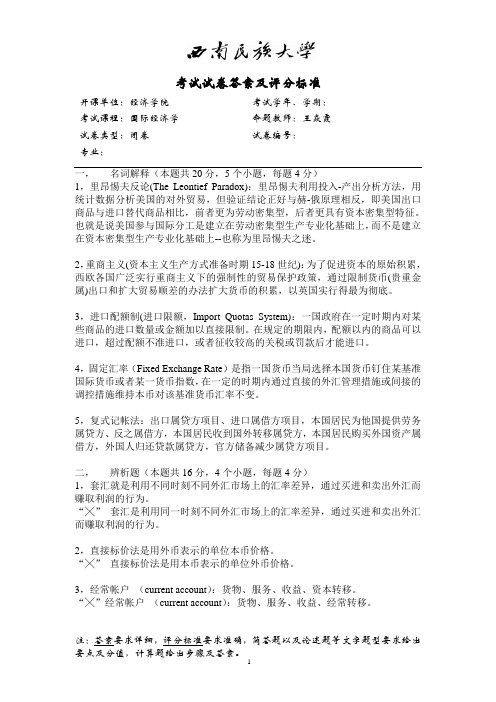
考试试卷答案及评分标准开课单位:经济学院考试课程:国际经济学考试学年、学期:命题教师:王焱霞试卷类型:闭卷专业:试卷编号:一,名词解释(本题共20分,5个小题,每题4分)1,里昂惕夫反论(The Leontief Paradox):里昂惕夫利用投入-产出分析方法,用统计数据分析美国的对外贸易,但验证结论正好与赫-俄原理相反,即美国出口商品与进口替代商品相比,前者更为劳动密集型,后者更具有资本密集型特征。
也就是说美国参与国际分工是建立在劳动密集型生产专业化基础上,而不是建立在资本密集型生产专业化基础上--也称为里昂惕夫之迷。
2,重商主义(资本主义生产方式准备时期15-18世纪):为了促进资本的原始积累,西欧各国广泛实行重商主义下的强制性的贸易保护政策,通过限制货币(贵重金属)出口和扩大贸易顺差的办法扩大货币的积累,以英国实行得最为彻底。
3,进口配额制(进口限额,Import Quotas System):一国政府在一定时期内对某些商品的进口数量或金额加以直接限制。
在规定的期限内,配额以内的商品可以进口,超过配额不准进口,或者征收较高的关税或罚款后才能进口。
4,固定汇率(Fixed Exchange Rate)是指一国货币当局选择本国货币钉住某基准国际货币或者某一货币指数,在一定的时期内通过直接的外汇管理措施或间接的调控措施维持本币对该基准货币汇率不变。
5,复式记帐法:出口属贷方项目、进口属借方项目,本国居民为他国提供劳务属贷方、反之属借方,本国居民收到国外转移属贷方,本国居民购买外国资产属借方,外国人归还贷款属贷方,官方储备减少属贷方项目。
二,辨析题(本题共16分,4个小题,每题4分)1,套汇就是利用不同时刻不同外汇市场上的汇率差异,通过买进和卖出外汇而赚取利润的行为。
“╳”套汇是利用同一时刻不同外汇市场上的汇率差异,通过买进和卖出外汇而赚取利润的行为。
2,直接标价法是用外币表示的单位本币价格。
“╳”直接标价法是用本币表示的单位外币价格。
《国际经济学》期末复习试卷5份和试题库含答案

《国际经济学》模拟试题及参考答案(一)一、名词解释(每小题5 分,共20 分)1.要素禀赋2.倾销3.黄金输送点4.三元悖论二、单项选择题:从下列每小题的四个选项中,选出一项正确的,将其标号填在题后的括号内。
(每小题2 分,共20 分)2.根据相互需求原理,两国均衡的交换比例取决于()A 两国的绝对优势B 两国的比较优势C 两国的相对需求强度D 两国的要素禀赋3.在当今的国际贸易格局中,产业内贸易更容易发生于()A 发展中国家与发达国家B 发达国家与发达国家C 发展中国家与发展中国家D 发展中国家和最不发达国家4.课征关税会增加生产者剩余,减少消费者剩余,社会总福利的变化将()A 上升B 降低C 不变D 不确定5.以下选项中,哪个选项不属于国际收支统计中居民的概念?()A 外国企业B 非盈利机构C 国际经济组织D 政府7.布雷顿森林体系创立了()A 以英镑为中心的固定汇率制度B 以美元为中心的固定汇率制度C 以英镑为中心的有管理的浮动汇率制度D 以美元为中心的有管理的浮动汇率制度8.在下列投资方式中,属于国际间接投资的是()A 在国外设立分公司B 在国外设立独资企业C 在国外设立合资企业D 购买国外企业债券9.经济非均衡的无形传导方式不包括()A 技术转让B 信息交流C 信息回授D 示范效应10.在斯图旺表中第三象限表示()A 通货膨胀与国际收支顺差并存B 衰退与国际收支顺差并存C 衰退与国际收支逆差并存D 通货膨胀与国际收支逆差并存三、判断正误题:正确的命题在括号里划"√",错误的命题在括号里划"×"。
(每小题2 分,共20 分)1.亚当。
斯密的绝对利益学说和大卫•李嘉图的比较利益学说都是从劳动生产率差异的角度来解释国际贸易的起因。
()2.出口的贫困化增长现象是一种普遍存在的现象,几乎所有国家都曾出现过,并且很难避免。
()3.国际贸易与国内贸易有相同的起因和特征,彼此之间不存在本质上的差别。
国际经济学试题试卷答案真题

国际经济学试卷一、单选题 (每题1分,共20分)1.J曲线效应是指( )。
A.一国的货币升值后,最初只会使国际收支状况进一步恶化,只有经过一段时滞以后,才会使贸易收入增加,并改善国际收支状况B.一国的货币贬值后,最初只会使国际收支状况进一步恶化,只有经过一段时滞以后,才会使贸易支出减少,并改善国际收支状况C.一国的货币贬值后,最初会使国际收支状况进一步改善,但只有经过一段时滞以后,贸易收入减少,并恶化国际收支状况D.一国的货币贬值后,最初只会使国际收支状况进一步恶化,只有经过一段时滞以后,才会使贸易收入增加,并改善国际收支状况2.当一国政府对某种产品征收进口关税时,若该产品的需求弹性大于供给弹性,生产者与消费者承担关税的程度是()。
A.前者大于后者B.后者大于前者C.两者相等D.不确定3.价格比较规范,不容易出现通货膨胀的汇率制度是( )。
A.固定汇率制B.自由汇率制C.管理汇率制D.浮动汇率制4.如果两国商品生产过程中都出现了中性技术进步,则两国的提供曲线( )。
A.都内移B.都外移C.一国内移,一国外移D.一国外移,一国不变5.具有明显政策优势的汇率制度是( )。
A.固定汇率制B.自由汇率制C.管理汇率制D.浮动汇率制6.在一定汇率条件下,一国物价水平普遍上升,导致出口下降、进口增加,国际收支趋于逆差,这种国际收支不平衡,属于( )。
A.周期性不平衡B.结构性不平衡C.收入性不平衡D.价格性不平衡7.根据S-S定理,如果劳动密集型产品的相对价格上升,劳动力的实际报酬将( )。
A.上升B.不变C.下降D.其它选项说法都不准确8.提供曲线,又叫( )。
A.无差异曲线B.贸易无差异曲线C.生产可能性曲线D.相互需求曲线9.目前,中国加入的地区经济一体化组织是( )。
A.北美自由贸易区B.中日——东盟自由贸易区C.IMFD.WTO10.居民在国外投资收益的汇回应该记入( )。
A.经常账户B.错误和遗漏账户C.资本和金融账户D.官方储备账户11.斯旺模型的原理说明当经济处于通货膨胀和国际收支顺差时,应采取的政策是( )。
国际经济学试题及答案(题库)
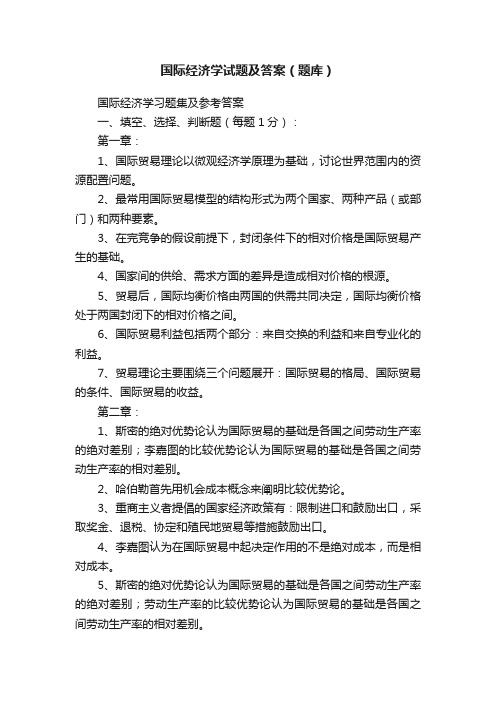
国际经济学试题及答案(题库)国际经济学习题集及参考答案一、填空、选择、判断题(每题1分):第一章:1、国际贸易理论以微观经济学原理为基础,讨论世界范围内的资源配置问题。
2、最常用国际贸易模型的结构形式为两个国家、两种产品(或部门)和两种要素。
3、在完竞争的假设前提下,封闭条件下的相对价格是国际贸易产生的基础。
4、国家间的供给、需求方面的差异是造成相对价格的根源。
5、贸易后,国际均衡价格由两国的供需共同决定,国际均衡价格处于两国封闭下的相对价格之间。
6、国际贸易利益包括两个部分:来自交换的利益和来自专业化的利益。
7、贸易理论主要围绕三个问题展开:国际贸易的格局、国际贸易的条件、国际贸易的收益。
第二章:1、斯密的绝对优势论认为国际贸易的基础是各国之间劳动生产率的绝对差别;李嘉图的比较优势论认为国际贸易的基础是各国之间劳动生产率的相对差别。
2、哈伯勒首先用机会成本概念来阐明比较优势论。
3、重商主义者提倡的国家经济政策有:限制进口和鼓励出口,采取奖金、退税、协定和殖民地贸易等措施鼓励出口。
4、李嘉图认为在国际贸易中起决定作用的不是绝对成本,而是相对成本。
5、斯密的绝对优势论认为国际贸易的基础是各国之间劳动生产率的绝对差别;劳动生产率的比较优势论认为国际贸易的基础是各国之间劳动生产率的相对差别。
6、在李嘉图模型中,生产可能性边界线方程是一个线性方程式,表示A、B两国的PPF曲线是一条直线段。
7、重商主义者提倡的国家经济政策有:限制进口和鼓励出口,采取奖金、退税、协定和殖民地贸易等措施鼓励出口。
8、李嘉图认为在国际贸易中起决定作用的不是绝对成本,而是相对成本。
9、机会成本概念表明:彼种选择的机会成本就构成此种选择的机会成本。
选择题:1、首先用机会成本理论来解释比较优势原理的学者是: C、A、李嘉图B、罗布津斯基C、哈伯勒D、穆勒第三章:1、要素禀赋理论最初是由赫克歇尔和俄林提出的,后经萨缪尔森等人加工不断完善。
国际经济学试卷及答案
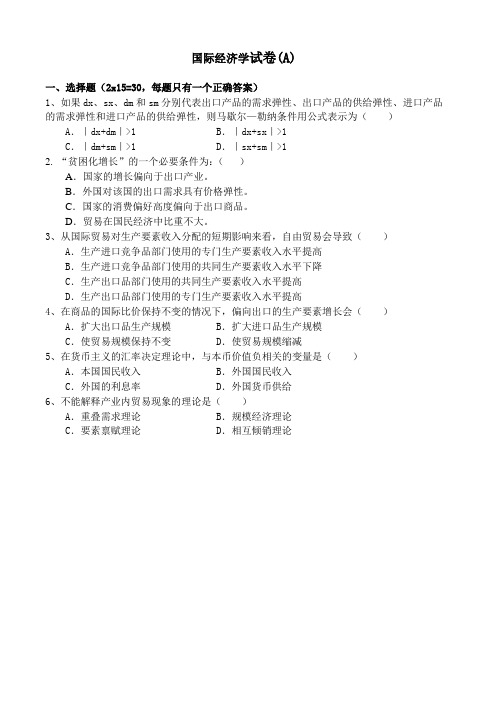
国际经济学试卷(A)
一、选择题(2x15=30,每题只有一个正确答案)
1、如果dx、sx、dm和sm分别代表出口产品的需求弹性、出口产品的供给弹性、进口产品的需求弹性和进口产品的供给弹性,则马歇尔—勒纳条件用公式表示为()A.|dx+dm|>1 B.|dx+sx|>1
C.|dm+sm|>1 D.|sx+sm|>1
2. “贫困化增长”的一个必要条件为:()
A.国家的增长偏向于出口产业。
B.外国对该国的出口需求具有价格弹性。
C.国家的消费偏好高度偏向于出口商品。
D.贸易在国民经济中比重不大。
3、从国际贸易对生产要素收入分配的短期影响来看,自由贸易会导致()
A.生产进口竞争品部门使用的专门生产要素收入水平提高
B.生产进口竞争品部门使用的共同生产要素收入水平下降
C.生产出口品部门使用的共同生产要素收入水平提高
D.生产出口品部门使用的专门生产要素收入水平提高
4、在商品的国际比价保持不变的情况下,偏向出口的生产要素增长会()
A.扩大出口品生产规模 B.扩大进口品生产规模
C.使贸易规模保持不变 D.使贸易规模缩减
5、在货币主义的汇率决定理论中,与本币价值负相关的变量是()
A.本国国民收入 B.外国国民收入
C.外国的利息率 D.外国货币供给
6、不能解释产业内贸易现象的理论是()
A.重叠需求理论 B.规模经济理论
C.要素禀赋理论 D.相互倾销理论。
- 1、下载文档前请自行甄别文档内容的完整性,平台不提供额外的编辑、内容补充、找答案等附加服务。
- 2、"仅部分预览"的文档,不可在线预览部分如存在完整性等问题,可反馈申请退款(可完整预览的文档不适用该条件!)。
- 3、如文档侵犯您的权益,请联系客服反馈,我们会尽快为您处理(人工客服工作时间:9:00-18:30)。
《国际经济学》模拟试卷13一、单项选择题(10小题,每小题1分,共10分):在小题后的括号内填上正确1、国际经济学的研究对象是()。
(绪论;第一节;第2页)A 稀缺资源在世界范围内的最优配置B 国际间的商品和生产要素的流动C 国际经济关系D上述都不是2.国际金融理论的发展一直是围绕着()这一十分重要的问题而展开的。
(绪论;第二节)A.外部平衡B.内部平衡C.外部平衡与内部平衡D.规模经济3、当生产可能性曲线外凸时,机会成本()。
(第一章;第一节;第13页)A 递增B 不变C 递减D 不变4、贸易利益可以分解为()。
(第一章;第三节;第21页)A 消费利益和自交换利益B 生产利益和自专业利益C 消费利益和生产利益D 上述都不是5. 对于进口配额与等额关税,如果让国内生产者来选择,他们会选择哪种措施()(第八章第一节第二节)A. 进口配额B. 等额关税C. 一样好D. 不确定6、林德从()方面探讨了国际贸易产生的原因。
(第五章;第一节;第93页)A 生产B 技术C 要素D 需求7.属于国际收支账户中服务项目的有()。
(第十二章;第二节)A.证券投资B.商品修理C.计算机和信息服务D.非货币黄金8.购买力平价论(the theory of purchasing power parity),简称PPP理论,是()在其1922年出版的《1914年以后的货币与外汇》(money and foreign exchange after 1914)中第一次系统阐述的。
(第十四章;第二节)A.勒纳B.卡塞尔C.凯恩斯D.多恩布什9.假设即期汇率l英镑=2美元,在欧洲市场美元一年期的利率为15%,英镑为10%,求一年后的远期汇率1英镑等于()美元。
A.2.091B.2C.1.913D.310. 在直接标价法下,一定单位的外国货币折算的本国货币的数额增大,说明()币值上升,汇率()。
(第十三章第一节)A. 本国货币;上升B. 外国货币;上升C. 本国货币;下降D. 外国货币;下降二、判断题(10小题,每小题1分,共10分):若判断正确,在小题后的括号内填上“√”号;若判断不正确,则在小题后的括号内填上“×”号。
1、产品的机会成本与成品的边际转换率呈绝对值相等的关系。
()(第一章;第一节;第12页)2、比较优势等同于比较成本。
()(第二章;第一节;第33页)3、要素禀赋的定义方法有两种。
()(第三章;第一节;第62页)4、罗布斯津基定理认为()。
(第四章;附录;第88页)5、制成品与制成品之间的产业内贸易反映比较优势。
()(第六章;第五节;第117页)6.产业内贸易反映比较优势。
()5-57.费雪模型证明,资本是从利率较低的国家流向利率较高的国家,即资本的流动是单向的,结果是各国的利率差消失。
这种分析是以不存在风险为前提的。
()10-1 8.汇率超调模型在长期强调商品市场的价格粘性。
()14-49.国际收支的弹性分析法是一种一般均衡分析。
()15-110.在浮动汇率制度下,如果资本具有完全的流动性,通过财政政策刺激总需求不会实现影响均衡产量或均衡收入的目的。
()17-2三、名词解释(4小题,每题5分,共20分)1. 生产者剩余(第一章第三节)2. 需求逆转(第四章第三节)3. 套期保值(第十三章第二节)4. 国际收支调整的乘数分析法(第十五章第三节)1. 试比较“新贸易理论”与比较优势理论之间的异同。
(第二章第六章)2. 贫困化增长发生的前提条件有哪些?(第四章附录)3. 简述考虑利率的弹性价格货币模型。
(第十四章第四节)4. 什么是汇率?根据不同的标价法应如何理解一国货币汇率的上升或下降?(第十三章第一节)五、计算题(1小题,共10分)请估算:(1)A国消费者从取消关税中可得到的收益。
(2)A国生产者从取消关税中遭受到的损失。
(3)取消关税导致的A国政府的关税的损失。
(4)取消关税对A国国民福利的影响。
利用国外资金是促进经济发展的重要手段之一,“二战”以后的西欧和日本、“亚洲四小龙”在经济发展的过程中,都成功地利用外资推动本国(地区)的民族工业经济走上快速发展的道路。
中国自20世纪70年代末实行改革开放政策以来,积极利用外资、不断拓展国际经济合作为促进当代中国经济社会的快速发展提供了重要支持。
下图是中国自1986年以来实际利用外资的情况(包括对外借款、吸收外商直接投资、外商其他投资)。
请根据要素国际流动理论解释要素的国际流动对资本母国和东道国的福利影响,并说明你对中国利用外资问题的看法。
数据来源:《中国统计年鉴2007》。
七、论述题(在以下两小题中任选一题,每题12分,共12分,如果两题都回答,只以第1.如何由贸易三角形推导提供曲线?(画图说明)2.简述国际经济政策协调的方式。
《国际经济学》试卷参考答案与评分标准一、单项选择题CAACA;DCBAB;二、判断题1、Х;2、√;3、Х;4、√;5、√;6.×;7.√;8.×;9.×;10.√三、名词解释1. 生产者剩余:是指生产者愿意接受的价格和实际接受的价格之间的差额。
2. 需求逆转:当某一国对于某一商品享有生产上的比较优势,但因其国民在消费上又特别地偏好该商品时,将会使得原来依据H-O定理所决定的进口方向发生改变,即发生了需求逆转。
3. 套期保值:就是通过卖出或买入等值远期外汇,轧平外汇头寸来实现保值的一种外汇业务。
4. 国际收支调整的乘数分析法:乘数分析法又称收入分析法,它是在假定价格和汇率不变的条件下,考察一国国民收入变动对其国际收支的影响。
它的基本论点是:进口支出是国民收入的函数,支出的变动通过乘数效应引起国民收入的变动,从而影响进口支出。
其影响程度取决于边际进口倾向和进口需求的收入弹性的大小、以及该国开放程度的高低。
四、简答题(4小题,每题7分,共28分)1. 答:产业间贸易和产业内贸易完全竞争市场和不完全竞争市场供给角度和需求角度同质产品和差异产品规模报酬不变和规模报酬递增2. 答:(1)经济增长偏向增长国的出口部门;(2)增长国在世界市场是一个大国,即其出口供给的变动足以影响世界价格;(3)增长国进口边际倾向较高,即增长国对进口的需求会因经济增长显著增加;(4)增长国出口产品在世界市场上需求价格弹性非常低。
3.答:可以用公式表示。
该式是弹性价格货币模型的基本形式,它将汇率的决定因素主要归结于三组变量:两国相对货币供给量、相对实际收入和相对利率。
4.答:汇率是以一国货币表示的另一国货币的价格。
直接标价法下一国货币汇率的上升表示该国货币的贬值,下降表示升值。
间接标价法下一国货币汇率的上升表示升值,下降表示贬值。
世界上大多数国家(包括我国)都采用直接标价法表示汇率,采用间接标价法的主要是美国和英国。
五、计算题 (1)2.5万美元 (2)1.4万美元 (3)0.4万美元(4)福利净增0.7万美元六、应用分析题 答:答题要点(1)能够正确画出资本国际流动效应分析模型图(教材第193页图10-6)——3分; (2)能够根据图形正确说明资本东道国和母国的福利效应——4分; (3)能够做出中国作为发展中国家可以扩大利用外资促进经济发展——1分; 能够就提高我国利用外资效率的措施提出合理意见,能自圆其说——2分。
本题也可以根据学生应用国际贸易理论解释问题的实际情况酌情判分,但要求回答内容能够自圆其说。
七、论述题1. 在图(a )图中,最初处于非贸易(自给自足)状态,生产点与消费点为E 0,国内价格线为P 0。
当国际价格线为P 1时,P 1>P 0,A 国的生产将移至E 1,消费点为C 1,贸易三角形为C 1D 1E 1,出口D 1E 1的X ,进口D 1C 1的Y 。
当价格线为P 2时,P 2>P 1,A 国的生产将移至E 2,消费点为C 2,贸易三角形为C 2D 2E 2,出口D 2E 2的X ,进口D 2C 2的Y 。
当国际价格线为P 0时,A 国出口X 与进口Y 的组合E 0为(0,0);当国际价格线为P 1时,A 国出口与进口的组合E 1为(D 1E 1,D 1C 1);当国际价格线为P 2时,A 国出口与进口的组合E 2为(D 2E 2,D 2C 2)。
连接E 0、E 1、E 2及用类似方法得到的点在图(b )中标出并连接,即可得到提供曲线。
它反映了为了进口一定数量的Y 而愿意出口X 的数量。
P 22. 进行国际经济政策协调的方式有两种:(1)相机性协调相机性协调是指根据经济面临的具体条件,在不存在规定各国应采取何种协调措施与规则的情况下,通过各国间的协商,确定针对某一特定情况,各国应采用的政策组合。
这一方法实际上是一国经济调控中相机决策的推广。
一般认为,这一方法的优点在于可以针对不同的条件就更为广泛的问题进行协调,而缺点在于可行性与可信性较差。
从可行性看,每次政策协调行动实际上意味着各国政府间的一次讨价还价,这样一次次的政策协调会带来很高的决策成本,并且也难对各国政府进行制约,易于产生竞相违约及搭便车现象,缺乏可持续性。
从可信性来看,这种方式下的协调措施完全由各国协商决定,缺乏明晰的规则,会产生较大的不确定性,难以通过影响公众的心理预期发挥政策效力。
(2)规则性协调规则性协调是指通过制定出明确规则来指导各国采取政策措施进行协调的协调方式。
规则性协调的优点在于决策过程清晰,政策协调可以在较长时期内稳定进行,可信性高,因此受到了更多的重视。
西方经济学者提出了一些很有影响的协调规则方案。
在此需要指出的是,如果货币金融方面的协调规则对各国实现内外均衡的一些基本问题都作了比较完整的规定,则这一协调规则实际上就构成了国际货币制度。
